Rev. December 20, 2015.
This essay details aspects of A Christmas Carol (1971, animated; The Stingiest Man in Town (1978); and A Christmas Carol (1954, TV, Basil Rathbone/Frederic March)).
Dicken’s A Christmas Carol, I am certain, lodged itself in the modern-culture secular way of keeping Christmas, in his lifetime, then its telling spread, or he took it to America, and then on stage, and then on film, by repetition, thus becoming part of the routine mechanisms of the holiday. This is likely due to the fact that as a whole the story is a redemption story, but a figurative or even allegorical one, in which Scrooge is not actually an old man, but the oldness in all observers and motion-goers of daily life, in a civilization, who let civilization and its affordances and limitations to sour them and turn them into reactionaries, and the ghosts are sent to knock him out that state and back into a free and easy state of relational acceptance of others based on their humanity. Because modern man has been being worn down by civilization for at least 150 years, this allegory of “getting into the Christmas spirit” is a key event in the telling.
But, for me, the Carol, many versions of which I have reviewed as ghost stories, also lends itself to analysis of how animators and movie maker choose to render the various ghosts, vis a vis Scrooge, and in terms of the state of dream or not that he is in. By studying what various directors did with a single ghost, for example, one can not only gain a sense of the instrumentalization of the ghost, but also the target state of mind. For example, the visitation of Marley. In this sequence, Scrooge appears to be awake, and yet he is visited by a ghost. As such, this could be construed as the only viable ghost sighting in the story, because he was awake when it happened. The three ghosts can all be alibi’d as figures of figmentation in a dream. But not Marley. Scrooge is settling in for the night, and he appears. So, the renderers of his appearance have a few special challenges.
In the Oscar winning 1971 animated version of the story, the appearance of Marley is one of the highlights of the whole film. This suggests that the telling is tilted in a bias in favor of Marley, that is, the sighting of real ghosts, and the belief that real ghosts can appear to waking humans. But, this version plays with the possibility that the whole sequence is already thrown in to an alternative state of consciousness, simply by taking place in the past, and in mythical London. As the movie opens, we do a vertical ferris wheel spin of the “camera” over the animation, which extracts physiognomies of haunting presences from the facades seen this way or that
 In this climate, there is a heightened sense of being able to pick physiognomies out of things, there is, then, a kind of figural fog placed over all, representing….what? A physiognomy is a face seen in a pattern or a facture due to a heightened activity of the apophenic capacity, charged to action by fear. That is, in a state of alert, the arousal creates a state where agency is activated, and in that aroused state a person is more likely than not to see a face in the pattern of a building. What this means is that even in his waking life, or, it is even possible, in our romantic-mythic retrospect on essentialist old London, the ground of the contemporary, 100 years ago, we are in a fearful, turned on to fear state, and aroused. For that, the space is magic, and activated by the appearance of temporary gods (as Cassirer called them). Thus, while Scrooge imagines he is fully awake, and in charge of his senses, in fact he is in a heightened state of fear, and therefore more susceptible to being haunted. He is, in short, in a hypnagogic state, but waking, a vigilogogic state (as I am calling them), in which the lattice of his life is weighed down by a persistent haunting thought: Marley. For that, it is no surprise that at his door knocker, he sees the lion wrongly as Marley
In this climate, there is a heightened sense of being able to pick physiognomies out of things, there is, then, a kind of figural fog placed over all, representing….what? A physiognomy is a face seen in a pattern or a facture due to a heightened activity of the apophenic capacity, charged to action by fear. That is, in a state of alert, the arousal creates a state where agency is activated, and in that aroused state a person is more likely than not to see a face in the pattern of a building. What this means is that even in his waking life, or, it is even possible, in our romantic-mythic retrospect on essentialist old London, the ground of the contemporary, 100 years ago, we are in a fearful, turned on to fear state, and aroused. For that, the space is magic, and activated by the appearance of temporary gods (as Cassirer called them). Thus, while Scrooge imagines he is fully awake, and in charge of his senses, in fact he is in a heightened state of fear, and therefore more susceptible to being haunted. He is, in short, in a hypnagogic state, but waking, a vigilogogic state (as I am calling them), in which the lattice of his life is weighed down by a persistent haunting thought: Marley. For that, it is no surprise that at his door knocker, he sees the lion wrongly as Marley
 The lion preexisting provides the physiognomy of the face an alibi to call it a mere ‘seeing things’ but in this version the closeness of the sighting, and the fact that they appear to look each other in the eye, means that he is aware of it, and in the same space as it. This version, then, unique in my viewings of many versions, then reverses the seeing of the face, by seeing Scrooge’s face as a phantom in the darkness in his own home. They are both placed, then, in a waking altered state, and state of being spooked
The lion preexisting provides the physiognomy of the face an alibi to call it a mere ‘seeing things’ but in this version the closeness of the sighting, and the fact that they appear to look each other in the eye, means that he is aware of it, and in the same space as it. This version, then, unique in my viewings of many versions, then reverses the seeing of the face, by seeing Scrooge’s face as a phantom in the darkness in his own home. They are both placed, then, in a waking altered state, and state of being spooked
 What this means is that, though he protests later, his rational modern mind has been compromised, and he has been cast back, like a new pagan, into the state of man prior to the solidification of reason as a blockage to superstition. Like an ancient greek he stands in magic space, the world alive with animism. Every thing is also a spirit and a god. I have commented in another note on the fact that it strikes me that in A Christmas Carol Dickens was writing up a modern version of an ancient Roman rite of worship of the gods of Saturnalia. All of the functional gods of ancient Rome were simply the phases and steps of life’s processes, figured out, given figure, so in this case Scrooge is in a state of seeing everything as a figure. If seen waking, though in a spooked state, then Marley manifests as nothing more or less than the equivalent of the presence of a functional god in ancient Rome. And in this case he is the god of the doorway, Fornuculus, he has about him some of the tasks of Mercury too, offering warnings, and, then, too, somehow, Dickens knew that in ancient Greece some statues were thought to be invested with troubled spirits, and to prevent them from wandering far the Greeks would actually chain them down to the spot, and make them keep still.
What this means is that, though he protests later, his rational modern mind has been compromised, and he has been cast back, like a new pagan, into the state of man prior to the solidification of reason as a blockage to superstition. Like an ancient greek he stands in magic space, the world alive with animism. Every thing is also a spirit and a god. I have commented in another note on the fact that it strikes me that in A Christmas Carol Dickens was writing up a modern version of an ancient Roman rite of worship of the gods of Saturnalia. All of the functional gods of ancient Rome were simply the phases and steps of life’s processes, figured out, given figure, so in this case Scrooge is in a state of seeing everything as a figure. If seen waking, though in a spooked state, then Marley manifests as nothing more or less than the equivalent of the presence of a functional god in ancient Rome. And in this case he is the god of the doorway, Fornuculus, he has about him some of the tasks of Mercury too, offering warnings, and, then, too, somehow, Dickens knew that in ancient Greece some statues were thought to be invested with troubled spirits, and to prevent them from wandering far the Greeks would actually chain them down to the spot, and make them keep still.
But this Fornuculus is also the god of the whole room and every surface in the room. This version has what is by far the most imaginative rendering of Marley ever. Every shot is a byplay between the whatamIseeing transparency of the ghost and Itsjustyourimagination appraisal of the elements of the décor of this room. It is as if Scrooge, sitting spooked in his high chair, cannot look at any surface in his empty room, and not think he is seeing a ghost. Thus, this Marley opens his mouth wide, his head foreshortened to create the effect that he is imagined as from the grain and the wood of the ceiling and its timbers
 That is, you can imagine Scrooge gazing in spooked state up at the grain of wood on his timbered ceiling, and think, what is that (this is not a novel effect, it shows up in Demon Seed, and in the 99 version of The Haunting, that is, ceiling bearing down on the spooked, as representing a figure pressing in. This Marley is also recursive. That is, after figuring him out of one position relative to the room and what he gives face and figure to, the scene shifts and he gives new figure and face to an apprehensive sense of that. Here, his mouth is now reimagined as emitted from the wainscot, and his eyes are reformatted as made of the wood grain knots on the ceiling, all of this disposition likely suggested by the similarity between the molding style and a row of teeth, around which a ghost is formed
That is, you can imagine Scrooge gazing in spooked state up at the grain of wood on his timbered ceiling, and think, what is that (this is not a novel effect, it shows up in Demon Seed, and in the 99 version of The Haunting, that is, ceiling bearing down on the spooked, as representing a figure pressing in. This Marley is also recursive. That is, after figuring him out of one position relative to the room and what he gives face and figure to, the scene shifts and he gives new figure and face to an apprehensive sense of that. Here, his mouth is now reimagined as emitted from the wainscot, and his eyes are reformatted as made of the wood grain knots on the ceiling, all of this disposition likely suggested by the similarity between the molding style and a row of teeth, around which a ghost is formed
 More conventionally, that gaping mouth, caused by rigor mortis, and prevented by the tie under the chin, according to burial lore then, can be seen in the woodgrain of the walls too, routinely so
More conventionally, that gaping mouth, caused by rigor mortis, and prevented by the tie under the chin, according to burial lore then, can be seen in the woodgrain of the walls too, routinely so
 That is, having seen his knocker, but with Marley on his mind, he sees the ghost of Marley, and is spooked, the ( ) space between Marley and the knocker is activiated, he is officially spooked, and then in his spooked state, having seen Marley in the doorknocker, he cannot help by in fear cower and counter to also see Marley in the molding, in the wood grain on the wall, and in the ceiling timbers too, in all the space, all around him, on three sides
That is, having seen his knocker, but with Marley on his mind, he sees the ghost of Marley, and is spooked, the ( ) space between Marley and the knocker is activiated, he is officially spooked, and then in his spooked state, having seen Marley in the doorknocker, he cannot help by in fear cower and counter to also see Marley in the molding, in the wood grain on the wall, and in the ceiling timbers too, in all the space, all around him, on three sides

I have said before that this haunting, using the door as the primary alibi for ‘its only imagination” rationalization, makes of Marley a Roman threshold god, a literal psychopomp, telling him what to expect, leading him into the world of spirits. It’s amazing, that it is here, lying deep in the subconscious of a British writer in the early 19th century, deep Roman haunting. But, then, two odd things happen, to make the haunting catch, or stick. Up to now, the haunting has been taking place in the middle ground of distance from him, in terms of proxemics, in the lattice, let’s say, of the space about him. But now, it comes in closer. The ghost out in the physical world, made real, extraverted, if you will, now introverts, it is sucked back inside Scrooge, as an externalization of his inner fears. This graph makes it known simply that he manifests a second time, swinging back over into the internal psychological space of Scrooge, inside that parentheses

Than by that second scare, convincing him of his reality, he knocks Scrooge upside down, now entirely under his control, as such
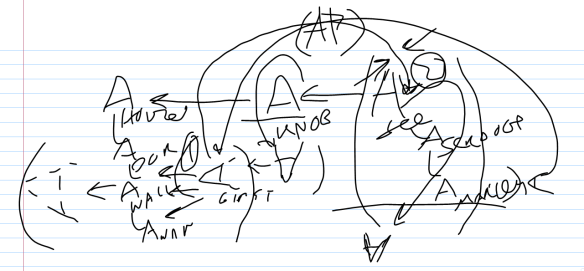
He is reduced by this complete frightening, into a deer in the headlights situation, that is, he is kind of paralyzed, and also, as is common in horror, rendered disemboweled, or scared shitless, unable to move, weak, depleted, emptied out. There is a name for that state, it is not effigy or mannequin, he is made into a target, for now I will just say that a deerintheheadlights target, a two dimensional being. But then, the big thing here that changes everything is that now the entire reality of the ghost can penetrate him, and in such a way that there develops a weird relation between two fixed states that I can only at the moment identify as a mirror relationship, in which the ghost takes the form of himself as seen in a mirror, his relationship with reality now also being a mirror relationship only. These are hag attacks very, very close to the body, here the pointing finger imagined up from the sight of own nose
 Then the actual pointing finger being composed of seeing the shadow of one’s nose in front of your crossed eyes
Then the actual pointing finger being composed of seeing the shadow of one’s nose in front of your crossed eyes
 then even seeing the ghost as a reflection of his chair, or a reflection of himself, in his nightshirt, in his pointed hat, in his pointed shoes, it is all just an externalization of his disemboweled, emptied out sense of self, reflecting itself on the world—I guess a kind of homunculus, but not quite, because of the mirror effect involve.
then even seeing the ghost as a reflection of his chair, or a reflection of himself, in his nightshirt, in his pointed hat, in his pointed shoes, it is all just an externalization of his disemboweled, emptied out sense of self, reflecting itself on the world—I guess a kind of homunculus, but not quite, because of the mirror effect involve.
This version also then magic slates it all away too (this also happens in the Finney version), so that he can momentarily think it all a hallucination. But these long shots, what do they say?
 For now, I will simply say that they seem to take the mirror effect relationship established in the intimate level of haunting, and then projects it out to all sense of all reality, so that the rest of the drama has dream room to move in, an extreme externalization. This movement ends with the vision of all the ghosts hidden behind the reality we live in, in this case it is a hecatonchir of a hundred hands, odd, since according to rhizome theory, our checkerboard rational perception of space in daily life, is, in fact, underlain with a hundred associations and linkages little appreciated by us, in fact, like this
For now, I will simply say that they seem to take the mirror effect relationship established in the intimate level of haunting, and then projects it out to all sense of all reality, so that the rest of the drama has dream room to move in, an extreme externalization. This movement ends with the vision of all the ghosts hidden behind the reality we live in, in this case it is a hecatonchir of a hundred hands, odd, since according to rhizome theory, our checkerboard rational perception of space in daily life, is, in fact, underlain with a hundred associations and linkages little appreciated by us, in fact, like this
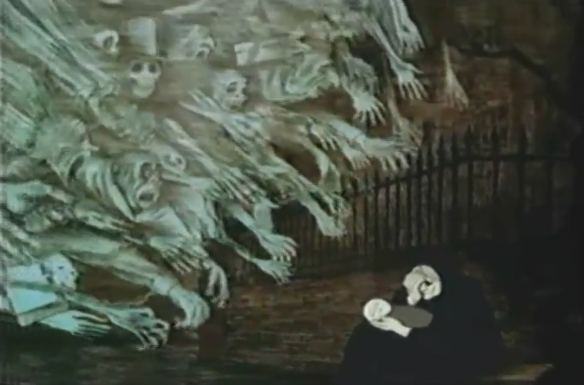 From this, then, it is apparent that the vision in the doorknocker cast Scrooge into an agency-activated fear state, in this state all the surfaces of his life doubled, and were suspect as haunting by figures. When the intensity of that latticing of it all was not enough, the ghost enraged clanged his boxes, to get his full attention. This then broke into Scrooge’s soul, inside his mind, and emptied him out, resulting in him becoming a depleted “victim” being haunted, and so paralyzed as to now reimagine the ghost as even more intense, as consisting of reflections of his own image and accessories projected into the world.
From this, then, it is apparent that the vision in the doorknocker cast Scrooge into an agency-activated fear state, in this state all the surfaces of his life doubled, and were suspect as haunting by figures. When the intensity of that latticing of it all was not enough, the ghost enraged clanged his boxes, to get his full attention. This then broke into Scrooge’s soul, inside his mind, and emptied him out, resulting in him becoming a depleted “victim” being haunted, and so paralyzed as to now reimagine the ghost as even more intense, as consisting of reflections of his own image and accessories projected into the world.
The Stingiest Man in Town (1978), a later telling by Rankin and Bass of a 50s TV version, has a different take on the nature of the haunting of Scrooge by Marley. In this version, Scrooge is already in bed (!, unique in my screening of many versions), and he appears at the end of the bed, in blue, meaning that he is simply being imagined as a classic hag attack. A hag attack is a feeling of discomfort during sleep which then manifests as the feeling that one is suffocating, then figured out, in dream form, as a hag sitting on your chest.
 It starts with a flickering of his lamp, in yellow tint, notice the wavering, and the pattern on the bedspread
It starts with a flickering of his lamp, in yellow tint, notice the wavering, and the pattern on the bedspread
 Then a shadow takes form at the foot of the bed
Then a shadow takes form at the foot of the bed
 His blueness, and his positioning vis a vis the bed, at the foot of it, at his feet, then too here the visual parallel between him and the pillow, it all reinforces the notion that this is a hag attack in male form by a body sleeping in bed.
His blueness, and his positioning vis a vis the bed, at the foot of it, at his feet, then too here the visual parallel between him and the pillow, it all reinforces the notion that this is a hag attack in male form by a body sleeping in bed.
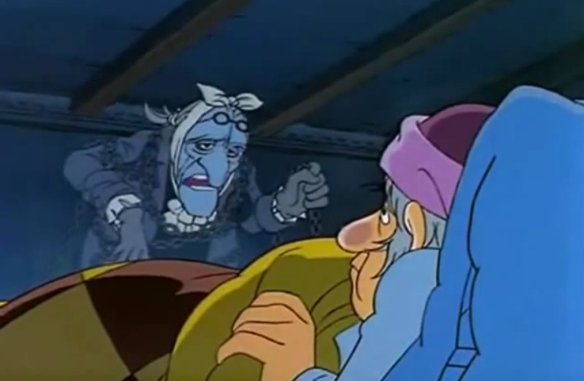 I know this is odd, but in this simple conceptualization, this version is not much different than Fuseli’s (or tradition’s) conception of a Nightmare
I know this is odd, but in this simple conceptualization, this version is not much different than Fuseli’s (or tradition’s) conception of a Nightmare
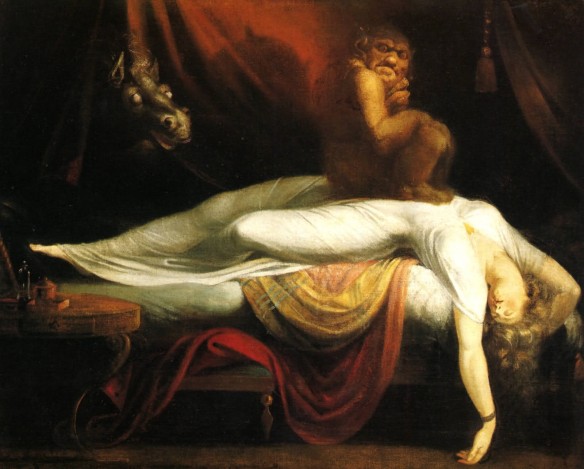 by means, then, of a rather chanting, haunting song, or not exactly a song, it is as if Marley drives Scrooge down into a deep dream state, to envision through an iris, his greed and selfishness. Oddly enough, this is where we confront Scrooge’s past, as he envisions gold coins, playing the part here of the visual static of something on one’s mind, before one drops off to sleep
by means, then, of a rather chanting, haunting song, or not exactly a song, it is as if Marley drives Scrooge down into a deep dream state, to envision through an iris, his greed and selfishness. Oddly enough, this is where we confront Scrooge’s past, as he envisions gold coins, playing the part here of the visual static of something on one’s mind, before one drops off to sleep
 But then it montages to another scene, and here too, we are now in a reverie in dream of coins, as the whole iris vignette, starting with figures, ends up being walled over, by gold coins, again unique
But then it montages to another scene, and here too, we are now in a reverie in dream of coins, as the whole iris vignette, starting with figures, ends up being walled over, by gold coins, again unique
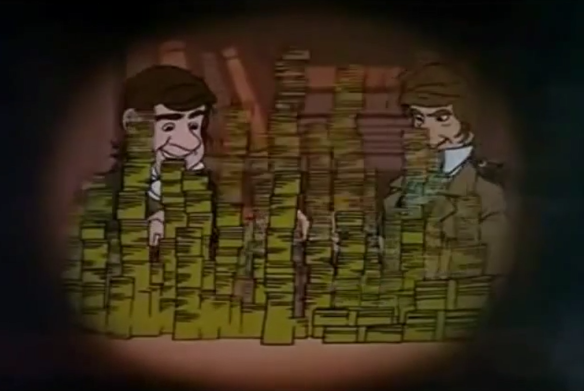 this scenario even casts Scrooge in his restless hypnagogic static-state into the remembrance of the death of Marley, the death that is of the pointing blue finger imputing this iris whirlpool of musing into him, the very figuring out and making narrative of his pointing finger, with his tombstone on the end, the cemetery. But, then, in a scene of remarkable creativity as Scrooge walks away, the tombstones having apparently momentarily banished through of riches out of his mind
this scenario even casts Scrooge in his restless hypnagogic static-state into the remembrance of the death of Marley, the death that is of the pointing blue finger imputing this iris whirlpool of musing into him, the very figuring out and making narrative of his pointing finger, with his tombstone on the end, the cemetery. But, then, in a scene of remarkable creativity as Scrooge walks away, the tombstones having apparently momentarily banished through of riches out of his mind
 No, he as if a magic elf, comes upon, in a gully in the cemetery, a new finding of another pile of gold, and is entirely enchanted, here in a dream state
No, he as if a magic elf, comes upon, in a gully in the cemetery, a new finding of another pile of gold, and is entirely enchanted, here in a dream state
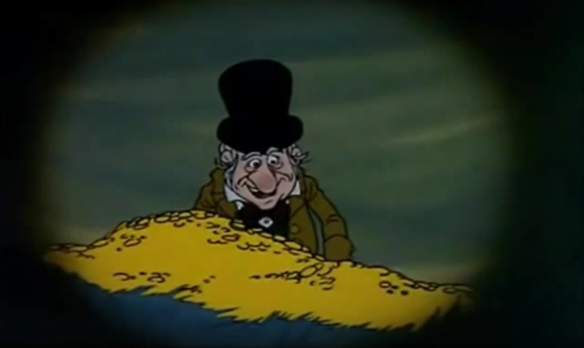 His eyes boggle, one imagines him glutting his imagination on it, and perhaps that signals that he wakes up, because the movie then makes another startlingly clever transition to envision his whole bed set up, its blanket, the light, the glow of the lamp, the ghost, all of it as all a great pile of heaping gold
His eyes boggle, one imagines him glutting his imagination on it, and perhaps that signals that he wakes up, because the movie then makes another startlingly clever transition to envision his whole bed set up, its blanket, the light, the glow of the lamp, the ghost, all of it as all a great pile of heaping gold
 With the blinding light of the static reverie in light sleep, induced by Marley’s haunting, now resolving back to being “awake” to the haunting, in his room (meaning that in this version they decided to simply format the Marley haunting according to that of all the others too).
With the blinding light of the static reverie in light sleep, induced by Marley’s haunting, now resolving back to being “awake” to the haunting, in his room (meaning that in this version they decided to simply format the Marley haunting according to that of all the others too).
 At present, I can only graph out the dynamics this way. A, Scrooge settles into his array of agencies, his bed, its cover, the light, but then his body passes through it all, nervous, still spooked, and as he nods off this elicits the appearance of the hag attack ghost, that ghost then points his finger at Scrooge, this finer reaches all the way up around the array of his bedding to as it were dig a hole in his head, in the iris of which we get an xray of what is on his mind in the static stage, still thinking of Marley and gold and the past, and then as the iris weakens, and concludes, it fades back to an appreciation of the bedding, and he returns to being awake, a triple loop, as it were, of a hag attack (this is not entirely satisfactory)
At present, I can only graph out the dynamics this way. A, Scrooge settles into his array of agencies, his bed, its cover, the light, but then his body passes through it all, nervous, still spooked, and as he nods off this elicits the appearance of the hag attack ghost, that ghost then points his finger at Scrooge, this finer reaches all the way up around the array of his bedding to as it were dig a hole in his head, in the iris of which we get an xray of what is on his mind in the static stage, still thinking of Marley and gold and the past, and then as the iris weakens, and concludes, it fades back to an appreciation of the bedding, and he returns to being awake, a triple loop, as it were, of a hag attack (this is not entirely satisfactory)
 This is very well done! Not only have I conjectured, in several versions I have reviewed, that the story in fact is paced and spaced out to the concern of three ghosts, because it is in fact Dickens’ very keen insight into the reality of the sleep of the elderly, repeatedly interrupted. The fact that this pile of gold envisioned in a static hypnagogic state fades back to the reality of his gold colored mound of bedspread, this too, is entirely interesting and realistic, as it is in the restless sleep of the elderly that the covers are repeatedly kicked off, the cold invades their sleeping body, they momentarily wake to pull it all back on, and on and on it goes, until things wake up all twisted all over the place (this motif played with a lot of the in the 1951 Sim version too). It could be said by this approach that Marley is a psychopomp in a more surgical way. That is, he comes in upon Scrooge, to core out an iris in his sleeping mind’s eye, down which now the further states of dream can rise up. That is, in his pointing finger, he cores out a spiraling down space in his head, a wormhole, if you will, and now Scrooge in other visits will spiral down in. Meaning that the further dreams are hypnagogic states-vis a vis-static state, that is sleep dysfunctionalisms, plummeting down. Then, once Marley leaves, we are left with the array of Scrooge in his bedding, as specified, light, goldbedspread, and bed, and then his “dreaming of” his exterior bodily self in different stages of sleep, prompted by having already been irised and bracketed, therefore, by a concern for gold, goes down the levels of sleep
This is very well done! Not only have I conjectured, in several versions I have reviewed, that the story in fact is paced and spaced out to the concern of three ghosts, because it is in fact Dickens’ very keen insight into the reality of the sleep of the elderly, repeatedly interrupted. The fact that this pile of gold envisioned in a static hypnagogic state fades back to the reality of his gold colored mound of bedspread, this too, is entirely interesting and realistic, as it is in the restless sleep of the elderly that the covers are repeatedly kicked off, the cold invades their sleeping body, they momentarily wake to pull it all back on, and on and on it goes, until things wake up all twisted all over the place (this motif played with a lot of the in the 1951 Sim version too). It could be said by this approach that Marley is a psychopomp in a more surgical way. That is, he comes in upon Scrooge, to core out an iris in his sleeping mind’s eye, down which now the further states of dream can rise up. That is, in his pointing finger, he cores out a spiraling down space in his head, a wormhole, if you will, and now Scrooge in other visits will spiral down in. Meaning that the further dreams are hypnagogic states-vis a vis-static state, that is sleep dysfunctionalisms, plummeting down. Then, once Marley leaves, we are left with the array of Scrooge in his bedding, as specified, light, goldbedspread, and bed, and then his “dreaming of” his exterior bodily self in different stages of sleep, prompted by having already been irised and bracketed, therefore, by a concern for gold, goes down the levels of sleep
 Each ghost then takes him on a climbing or not journey in the complicated layerings of dreaming, all of it prompted by static obsession with gold, its inducing thematic element
Each ghost then takes him on a climbing or not journey in the complicated layerings of dreaming, all of it prompted by static obsession with gold, its inducing thematic element
 This would explain then the fantastical depiction of the world of the ghost of the past as a musical interlude entirely embodying in a vision of gold Scrooge’s vision of his dreams, not the ghost’s showing him, astonishingly creative. The facets of the chandelier closeup, then the spiral of the dance, send him down in
This would explain then the fantastical depiction of the world of the ghost of the past as a musical interlude entirely embodying in a vision of gold Scrooge’s vision of his dreams, not the ghost’s showing him, astonishingly creative. The facets of the chandelier closeup, then the spiral of the dance, send him down in
 and then at the bottom of that chamber of the brain, deep dream state dropped through the whoosh from the static, they live in a pure dream, all gold, living eidols of the portrait of the queen, wonderful
and then at the bottom of that chamber of the brain, deep dream state dropped through the whoosh from the static, they live in a pure dream, all gold, living eidols of the portrait of the queen, wonderful
 This is how I map out the particular journey that the Past takes him on, in this version, starts with gold static, stays with it, drops to his dream, prompted by added push downward by musical interelude fantasy allowance, then rises back up to them in that dream gold house, dancing in the lattice under the chandelier and the eidol of gold of their future royalness embodied in that mystic little portrait in the bottom of his static-dreaming dysfunctional plunge
This is how I map out the particular journey that the Past takes him on, in this version, starts with gold static, stays with it, drops to his dream, prompted by added push downward by musical interelude fantasy allowance, then rises back up to them in that dream gold house, dancing in the lattice under the chandelier and the eidol of gold of their future royalness embodied in that mystic little portrait in the bottom of his static-dreaming dysfunctional plunge
 the ghost of the present also takes us down through the golden door composed of the stuff of the static dream stage
the ghost of the present also takes us down through the golden door composed of the stuff of the static dream stage
 but then that substance also whooshes and in fact tumbles him down, miniaturizing him, as, as you fall down the turned around telescope, you do quite literally undergo a reduction to accommodate the micropsia below, in an admittedly odd sequence of tiny Scrooge under the tree (imitated by the Carey version later)
but then that substance also whooshes and in fact tumbles him down, miniaturizing him, as, as you fall down the turned around telescope, you do quite literally undergo a reduction to accommodate the micropsia below, in an admittedly odd sequence of tiny Scrooge under the tree (imitated by the Carey version later)
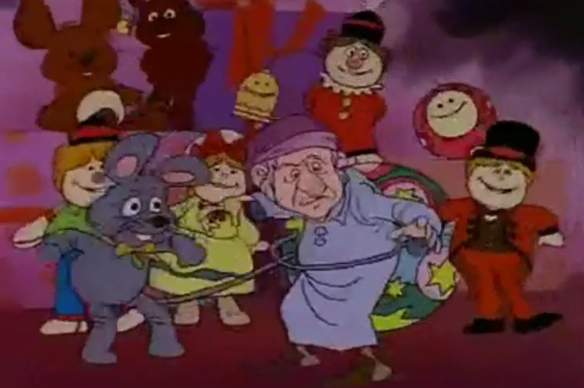 this interior descent even allows the dreaming mind to touch down on rock bottom of under the tree essence of Christmas, and even bring in a religious element as a crèche is down there at the bottom of the whoosh
this interior descent even allows the dreaming mind to touch down on rock bottom of under the tree essence of Christmas, and even bring in a religious element as a crèche is down there at the bottom of the whoosh
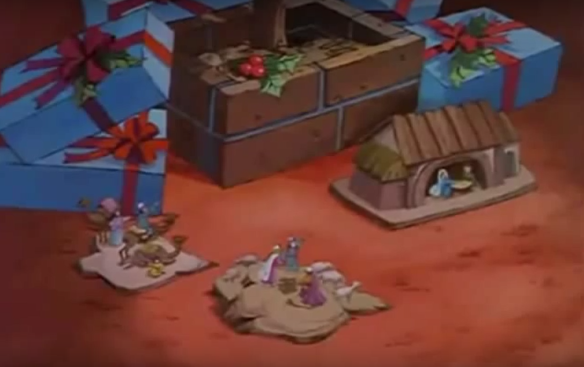 and this then swells back up like lava up out of a volcano to momentarily reimagine the whole golden static veneer of his dreaming as a religious awakening, odd, unique
and this then swells back up like lava up out of a volcano to momentarily reimagine the whole golden static veneer of his dreaming as a religious awakening, odd, unique
 And this is how this remarkably weird sequence goes, a different path, a static entry, a quick zap plunge down, deep inhabitatiotn of total deep dream surreal state, but then a psychopomp bug even there, to coopt it and hop it over to a religious moment, on that that then riding the lava back up the dream shaft through the stained glass, and the rose window, to the vision of the mandala, and back to consciousness. Weird.
And this is how this remarkably weird sequence goes, a different path, a static entry, a quick zap plunge down, deep inhabitatiotn of total deep dream surreal state, but then a psychopomp bug even there, to coopt it and hop it over to a religious moment, on that that then riding the lava back up the dream shaft through the stained glass, and the rose window, to the vision of the mandala, and back to consciousness. Weird.
This is all that I have at present for the manifestations and movements of the ghosts in psychopomp patterns in Scrooge’s arrayed dream states. But, then, there is one other depiction of Marley’s visit, in modernist outings, that is decidedly weird, in several ways. And this is in the 1954 version where Frederic March Plays Scrooge, and Basil Rathbone comes in as Marley. Here, too, as in other versions I have noted here, the Marley section gains the most attention, that is, the warning, and then it goes from there.
In this version, Scrooge never goes to bed. He also lives in a very small little room, and its smallness bothers him as as soon as he gets home he wants the maid out, and complains of the noise of carols still coming in from the street . The maid is an apprehensive employed, backing out grovelingly cautious to his temper
 He, therefore, is more in a waking annoyed state, a cat on a hot tin roof, trying to calm down, to get comfortable, to undo the haunting he has had out front. He cant do it, and so no sooner does she leave that then door is busy again and now Marley comes in as if a personification of the door, but the return in annoyance of the maid, but as a ghost
He, therefore, is more in a waking annoyed state, a cat on a hot tin roof, trying to calm down, to get comfortable, to undo the haunting he has had out front. He cant do it, and so no sooner does she leave that then door is busy again and now Marley comes in as if a personification of the door, but the return in annoyance of the maid, but as a ghost
 he then warns him as he will, and as he has in so many versions, in this one here a physiognomy of a picture on the wall, and there had been his portrait on the mantel in the office, and as a face seen in the patterns of his wallpaper, nothing more, it is OK, but not terrific
he then warns him as he will, and as he has in so many versions, in this one here a physiognomy of a picture on the wall, and there had been his portrait on the mantel in the office, and as a face seen in the patterns of his wallpaper, nothing more, it is OK, but not terrific
 But, then, something very strange happens. When asked if he can sit down, he does, and at his table. Now it is as if he is back to as was ante status quo of seven years ago just sitting at the table with Scrooge, and this body language and proxemics would be entirely comfortable and taken for granted by Scrooge, but also spook him, for it to be back. And then, in the most thrillingly odd touch in this version, he touches, he takes hold of Scrooge
But, then, something very strange happens. When asked if he can sit down, he does, and at his table. Now it is as if he is back to as was ante status quo of seven years ago just sitting at the table with Scrooge, and this body language and proxemics would be entirely comfortable and taken for granted by Scrooge, but also spook him, for it to be back. And then, in the most thrillingly odd touch in this version, he touches, he takes hold of Scrooge
 Scrooge recoils, with revulsion, to be touched by a ghost, full of miasmic bad air, and decay and corruption, notice that this scene takes place well within sight of a washing bowl and a towel. But then they have a full on engagement, a conversation
Scrooge recoils, with revulsion, to be touched by a ghost, full of miasmic bad air, and decay and corruption, notice that this scene takes place well within sight of a washing bowl and a towel. But then they have a full on engagement, a conversation
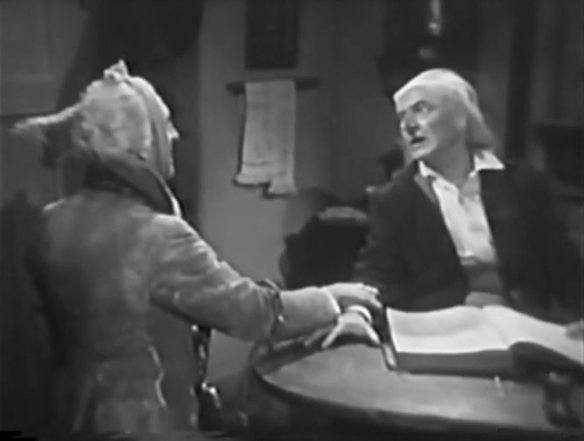 He brings out, from the floor below, a physical artifact, proving his reality, breaking through the barrier of dream, in the world of his life, the counting book
He brings out, from the floor below, a physical artifact, proving his reality, breaking through the barrier of dream, in the world of his life, the counting book

It is just very odd. This version made no attempt to position Marley’s appearance inside the appearance of a dream, or inside Scrooge’s head, it is played as if a revisiting memory of an everyday engagement with his erstwhile partner. That touch, however, would represent it all as a common dream phenomenon, as people asleep do sometimes think they feel a touch, so perhaps this is a sleepwalking episode. I am not sure. But, then, the main point is that this haunting gets most interesting when Marley visually departs. Because as he does he goes on a chant and then that chant takes hold of Scrooge as if an earworm that whirls around in his brain. And it haunts the whole room, and makes him spin in it, it is as if is occupies all the night and all creation, it resounds, and Scrooge spins one way, a genre picture representing his whole reality permeated by it
 and then another
and then another
 and then he spins around again, now truly haunted, but by the noise, by the effect of the presence of Marley, spinning in, coring down in his ear, and head, and making of his head an echo chamber where the difference between material and ghostly reality disappears
and then he spins around again, now truly haunted, but by the noise, by the effect of the presence of Marley, spinning in, coring down in his ear, and head, and making of his head an echo chamber where the difference between material and ghostly reality disappears
 this even, then, causes him to fall, it is, then, a dizzy spell too, a complete disorientation of an old body, and he falls in the corner by the furnace, and even cowers, he is entirely undone by it
this even, then, causes him to fall, it is, then, a dizzy spell too, a complete disorientation of an old body, and he falls in the corner by the furnace, and even cowers, he is entirely undone by it
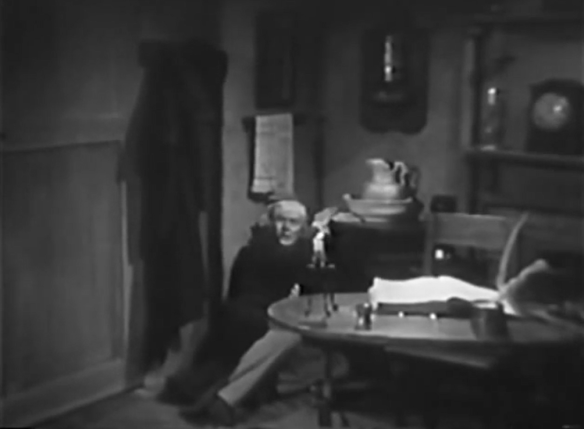 at present, simply using the excavation of dream state model developed earlier in this outing, I am going to posit that while most of Marley’s visit happened in conscious space, when he took hold of Scrooge’s hand, he flinched, and then the figures on the pages of the counting book made real rooted the visit at the level of the glass onion, a world of figures where they lived, and then it is from this state, the whir of all those figures, all the time they wasted, all the bad business they did, but represented symbolically only by that book, as proof of the haunting, that that stirs up, also with the wake gust of his departure, and then unnerving Scrooge by touch, as a nervous reaction in him, to the static level from the GO level, the whirring haunting threnody, but then something weird happens. And I am not entirely sure how to chart out this fact. It is as if by switching from a visual clue, by the effort to imagine the impact of a nervous breakdown on his mind, to an aural one, the pulse of the dreaming umbrellas out across the property provided for it, to represents its whole encapsulation of his world, that genre painting that he backs himself up against
at present, simply using the excavation of dream state model developed earlier in this outing, I am going to posit that while most of Marley’s visit happened in conscious space, when he took hold of Scrooge’s hand, he flinched, and then the figures on the pages of the counting book made real rooted the visit at the level of the glass onion, a world of figures where they lived, and then it is from this state, the whir of all those figures, all the time they wasted, all the bad business they did, but represented symbolically only by that book, as proof of the haunting, that that stirs up, also with the wake gust of his departure, and then unnerving Scrooge by touch, as a nervous reaction in him, to the static level from the GO level, the whirring haunting threnody, but then something weird happens. And I am not entirely sure how to chart out this fact. It is as if by switching from a visual clue, by the effort to imagine the impact of a nervous breakdown on his mind, to an aural one, the pulse of the dreaming umbrellas out across the property provided for it, to represents its whole encapsulation of his world, that genre painting that he backs himself up against
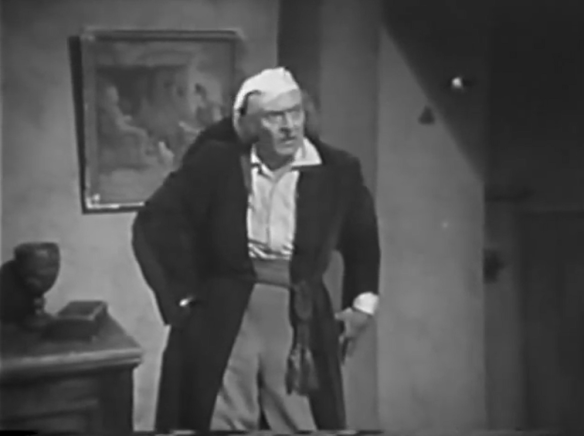 And by that device, fans out through the stages, to create a true ‘echo chamber’ below, something like this
And by that device, fans out through the stages, to create a true ‘echo chamber’ below, something like this
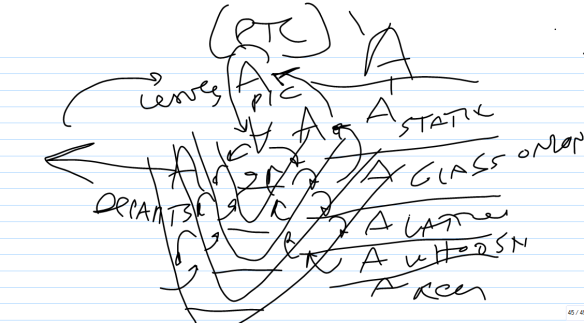 And it is in this echo chamber, where all stages echo on all others, that SONG takes over, and SONG is the primary medium by which the dream states are conveyed. Now, on that point, most of the songs are terrible, but as it moves through, it is of some interest, in keeping with the descent of the dreams from the device portal of the genre painting, that the windows of his room
And it is in this echo chamber, where all stages echo on all others, that SONG takes over, and SONG is the primary medium by which the dream states are conveyed. Now, on that point, most of the songs are terrible, but as it moves through, it is of some interest, in keeping with the descent of the dreams from the device portal of the genre painting, that the windows of his room
 Simple opyn up to the ballroom, just adjacent to it, as if an echo of it, again a kind of mirror image (indicating to use the above model that he is fixated, an thus only seeing a world mirroring his projecting fears)
Simple opyn up to the ballroom, just adjacent to it, as if an echo of it, again a kind of mirror image (indicating to use the above model that he is fixated, an thus only seeing a world mirroring his projecting fears)
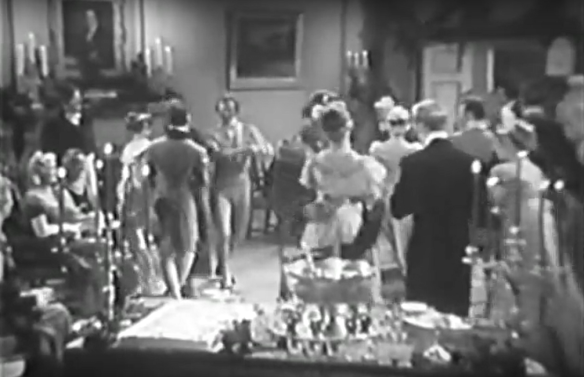 then too, as in the Edison version, his room is simply the vehicle by which other spaces are imagined, his bowl of porridge
then too, as in the Edison version, his room is simply the vehicle by which other spaces are imagined, his bowl of porridge
 Then dissolves into the Cratchits table, right there
Then dissolves into the Cratchits table, right there
 But then, it is as if as the utterly ridiculous scene where Tiny Tim sings some anthem, his body begins his dreaming mind to wake up, and as he rises up, his body begins to worry about itself again, and we see in the worries of an old body, wondering as if by an overvoice of rationale, how would Tiny Tim get up to the top of that tree, and so as we climb back up and in we get what is by far this version’s strangest manifestation, the triple decker chair stack by which crippled Tiny Tim is allowed to climb up to put the star on the tree
But then, it is as if as the utterly ridiculous scene where Tiny Tim sings some anthem, his body begins his dreaming mind to wake up, and as he rises up, his body begins to worry about itself again, and we see in the worries of an old body, wondering as if by an overvoice of rationale, how would Tiny Tim get up to the top of that tree, and so as we climb back up and in we get what is by far this version’s strangest manifestation, the triple decker chair stack by which crippled Tiny Tim is allowed to climb up to put the star on the tree
 But then to prove that in this version it was all about an old body worrying most of all about death, the disastrous intervening scenes retract back directly out the Cratchit window, to see a bird in a tree, on set, and that chanting death threnody begins again, eerily, as before, haunting
But then to prove that in this version it was all about an old body worrying most of all about death, the disastrous intervening scenes retract back directly out the Cratchit window, to see a bird in a tree, on set, and that chanting death threnody begins again, eerily, as before, haunting
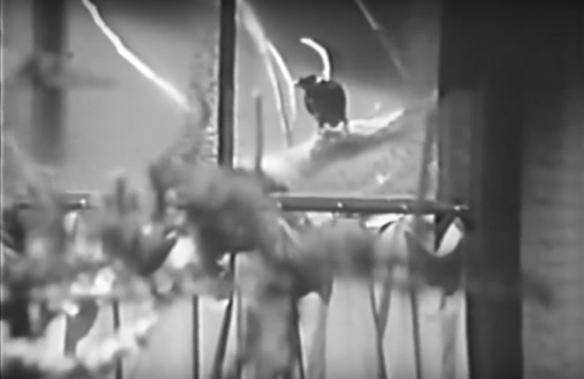 As if to pick up again on the fact that all of this is entirely but the echolations of the original death spiral chant that spun an earworm in Scrooge’s head, and then the camera swings round that bird, almost like a bird in Whitman’s poem on Lincoln’s passing, and we swing by it
As if to pick up again on the fact that all of this is entirely but the echolations of the original death spiral chant that spun an earworm in Scrooge’s head, and then the camera swings round that bird, almost like a bird in Whitman’s poem on Lincoln’s passing, and we swing by it
 into the foggy cemetery, step by step, dollying, really, quite done up, pulling apart, as it were, the whole piece
into the foggy cemetery, step by step, dollying, really, quite done up, pulling apart, as it were, the whole piece
 through the spooky sticks to the graveyard scene
through the spooky sticks to the graveyard scene
 meaning that this version was pretty much all about that all the time but then Scrooge is back in his bed, done
meaning that this version was pretty much all about that all the time but then Scrooge is back in his bed, done
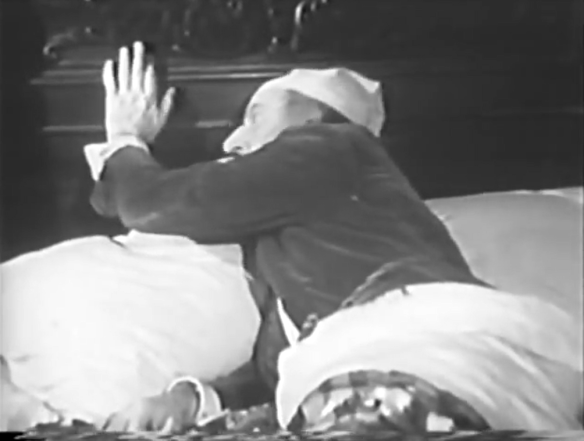 The whole thing suggests that the weird in between dream states were in fact attempts by his unconscious mind to block out what the implications of Marley’s touch and his nervous response to it meant to him, ie that it was the touch of death, and that it unnerved him, so in the echo chamber created by that unnverving, were musical orbitings of good cheer designed to relieve his mind of the weight of it, which existed in conscious life, that is, errant dream states blocking, obscuring, moving out laterally, away from the whoosh, lingering fuguelike in light sleep
The whole thing suggests that the weird in between dream states were in fact attempts by his unconscious mind to block out what the implications of Marley’s touch and his nervous response to it meant to him, ie that it was the touch of death, and that it unnerved him, so in the echo chamber created by that unnverving, were musical orbitings of good cheer designed to relieve his mind of the weight of it, which existed in conscious life, that is, errant dream states blocking, obscuring, moving out laterally, away from the whoosh, lingering fuguelike in light sleep
 and then at the end, after his mind again begins to surface, wondering on how Tiny Tim got that star up there, and seeing that awful makeshift ladder of unstable chairs, and thought of that, in the back of his mind, and the touch of that star, associated with the touch of death,and so his mind surged upward in a dream dysfunction almost akin to sleep paralysis, to rise up from deep dream to static state just shy of consciousness, and hear that awful lament again haunt him, to then wake him, to be relieved to be awake, redeemed, alive
and then at the end, after his mind again begins to surface, wondering on how Tiny Tim got that star up there, and seeing that awful makeshift ladder of unstable chairs, and thought of that, in the back of his mind, and the touch of that star, associated with the touch of death,and so his mind surged upward in a dream dysfunction almost akin to sleep paralysis, to rise up from deep dream to static state just shy of consciousness, and hear that awful lament again haunt him, to then wake him, to be relieved to be awake, redeemed, alive
 By its emphasis on Scrooge’s disgust with the touch of death, the flight of dreams is less helpful than in other versions, in fact might be construed as blockages, but then the version pulls one out of the hat with that bizarre detail of Tiny Tim’s ladder, and the star, which makes an associative nightmare connection with that dreaded touch from the haunting, and he surfaces, terrified, only to then be relieved to be awake and alive, for that to redeem. All in all, then, all these three versions oddly seemed to emphasize Marley, and how as a psychopomp he not only announced the dreams to Scrooge, but laid out the landscape or map of how the dream states would be navigated for specific dream redeeming purpose in each version. Great variations, with my treatment attempting to figure out why each version had its strengths and weaknesses.
By its emphasis on Scrooge’s disgust with the touch of death, the flight of dreams is less helpful than in other versions, in fact might be construed as blockages, but then the version pulls one out of the hat with that bizarre detail of Tiny Tim’s ladder, and the star, which makes an associative nightmare connection with that dreaded touch from the haunting, and he surfaces, terrified, only to then be relieved to be awake and alive, for that to redeem. All in all, then, all these three versions oddly seemed to emphasize Marley, and how as a psychopomp he not only announced the dreams to Scrooge, but laid out the landscape or map of how the dream states would be navigated for specific dream redeeming purpose in each version. Great variations, with my treatment attempting to figure out why each version had its strengths and weaknesses.
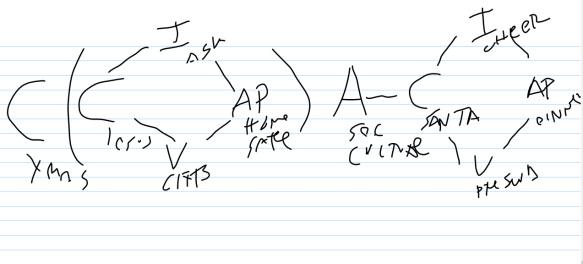


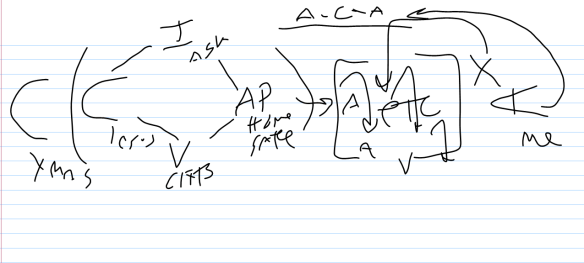


 The same effect occurred in terms of how men especially, especially of the golf set generation, with their Frank Sinatra sense of seasonal glamor, back from the war, dressed up for the holiday and ensured their buy in to it by a quick donning of a festive sweater. There was a time when ugly sweaters showed up and they were not considered ugly, they were beautiful, if jejune gestures, the man of the house deferring to the day, but doing so in a way with a whiff of insincerity, a bit much. You can see this unironic, but not quite entirely right sweaters in, for example, the Omen II
The same effect occurred in terms of how men especially, especially of the golf set generation, with their Frank Sinatra sense of seasonal glamor, back from the war, dressed up for the holiday and ensured their buy in to it by a quick donning of a festive sweater. There was a time when ugly sweaters showed up and they were not considered ugly, they were beautiful, if jejune gestures, the man of the house deferring to the day, but doing so in a way with a whiff of insincerity, a bit much. You can see this unironic, but not quite entirely right sweaters in, for example, the Omen II
 You can find theses sweaters all through the 60s and the 70s, they were sincere attempts to make for fun and festivity, by the man of the house giving in to the day in this quick easy allover way. A really good example of their appearance, rather late in the day, is in 1991’s Campfire Tales, where the sister in law of a killer wears a completey unironic and very ugly Christmas tree sweater
You can find theses sweaters all through the 60s and the 70s, they were sincere attempts to make for fun and festivity, by the man of the house giving in to the day in this quick easy allover way. A really good example of their appearance, rather late in the day, is in 1991’s Campfire Tales, where the sister in law of a killer wears a completey unironic and very ugly Christmas tree sweater And then, she even has her daughter wearing a pink Santa Claus sweater, both of them serving to increase the brother-killer’s sense that Christmas is crazy, and he is not in the spirit
And then, she even has her daughter wearing a pink Santa Claus sweater, both of them serving to increase the brother-killer’s sense that Christmas is crazy, and he is not in the spirit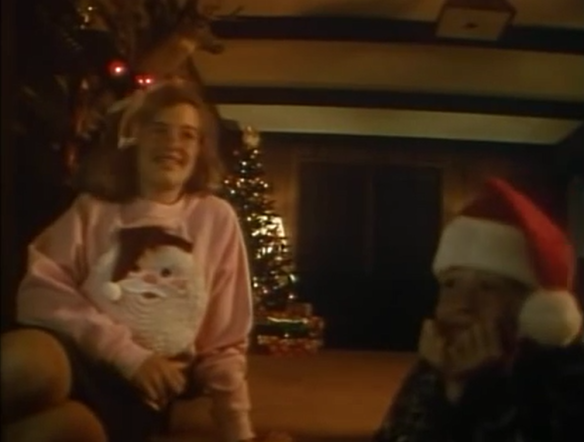 But this outing, in particular, suggests the first inkling of the turning of the ugly sweater from it’s happy innocent stage, to its horror stage, that is, a sign of Christmas curdling. Later on, when Krampus appears, his outfit is basically santa’s outfit, but it is rotten, and dirty, and green, an inversion of the normal covering of Santa in his good cheer red
But this outing, in particular, suggests the first inkling of the turning of the ugly sweater from it’s happy innocent stage, to its horror stage, that is, a sign of Christmas curdling. Later on, when Krampus appears, his outfit is basically santa’s outfit, but it is rotten, and dirty, and green, an inversion of the normal covering of Santa in his good cheer red And, then, it is my conjecture, from later tellings, that as the ugly sweater became alienated from the person, and existed as an overlay over a person in a way that no longer represented him or her, but was draped over it to force compliance to some expectation of an ideal, it became as it were a trophy, an abstract depiction of the forced good cheer of the person. This, in fact, happens in this outing, with the wreathe on the door. When it is first seen, he hates it, it symbolizes the keeping of a holiday he does not care about, and wants over. And it represents the fact that the person who put it up there is still alive, and he wants her dead. It welcomes people in. But, later, an inversion, he gets the opposite, an attack at the door, the opposite of a wreathe, the mysterious four hard knocks on the door, and then on that welcoming votive, and inverted, ugly votive, a threat, a dirty green stocking filled with coal
And, then, it is my conjecture, from later tellings, that as the ugly sweater became alienated from the person, and existed as an overlay over a person in a way that no longer represented him or her, but was draped over it to force compliance to some expectation of an ideal, it became as it were a trophy, an abstract depiction of the forced good cheer of the person. This, in fact, happens in this outing, with the wreathe on the door. When it is first seen, he hates it, it symbolizes the keeping of a holiday he does not care about, and wants over. And it represents the fact that the person who put it up there is still alive, and he wants her dead. It welcomes people in. But, later, an inversion, he gets the opposite, an attack at the door, the opposite of a wreathe, the mysterious four hard knocks on the door, and then on that welcoming votive, and inverted, ugly votive, a threat, a dirty green stocking filled with coal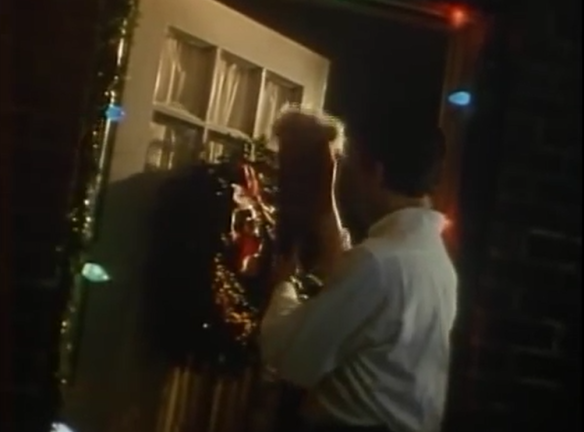 and then, when Krampus takes him all the way to the eye-for-an-eye equation of his act, he ends up as the very opposite of the wreathe, and the door, closing down, blocking out the holiday, a sacrificial trophy in revenge for bad deeds done. So, my thought is while ugly sweaters did not suffer this fate in this outing, they were on the verge of beginning to curdle in the same way
and then, when Krampus takes him all the way to the eye-for-an-eye equation of his act, he ends up as the very opposite of the wreathe, and the door, closing down, blocking out the holiday, a sacrificial trophy in revenge for bad deeds done. So, my thought is while ugly sweaters did not suffer this fate in this outing, they were on the verge of beginning to curdle in the same way It was only when that custom became tired and ersatz, and out of date, that fissures, according to my theory of migration of cultural forms across generations, began to open up and be wincable at to the younger generation. I do not recollect my dad ever donning an ugly sweater so it was not part of my complaint (but his Christmas music was, and then his Christmas tree habits). But, no doubt, others felt that way, as it was by the ugly sweater, which, as it began to grow more and more dated, began to makes the young kids wince. That is, it became part of the Disaster Christmas, and I am pretty sure there are a few of them in Christmas Vacation, and a few devices of horror, the uncle whose suit is on fire, the cat that spends its last ninth life, that vamp on the notion of wearing ugly furs for the holidays.
It was only when that custom became tired and ersatz, and out of date, that fissures, according to my theory of migration of cultural forms across generations, began to open up and be wincable at to the younger generation. I do not recollect my dad ever donning an ugly sweater so it was not part of my complaint (but his Christmas music was, and then his Christmas tree habits). But, no doubt, others felt that way, as it was by the ugly sweater, which, as it began to grow more and more dated, began to makes the young kids wince. That is, it became part of the Disaster Christmas, and I am pretty sure there are a few of them in Christmas Vacation, and a few devices of horror, the uncle whose suit is on fire, the cat that spends its last ninth life, that vamp on the notion of wearing ugly furs for the holidays.

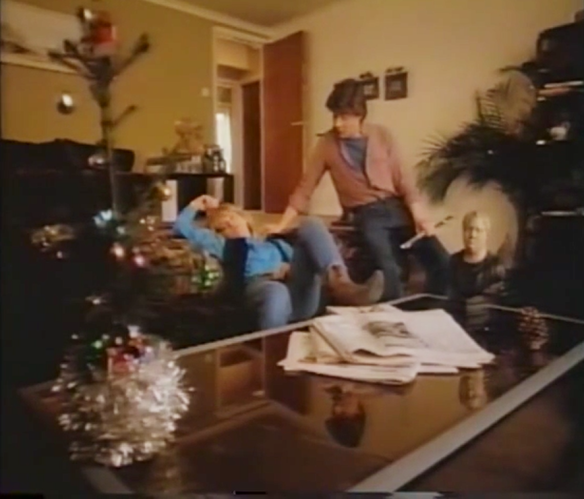 And then, in her, not his flat, her very incidental Christmas decorations, first, just in the door, one strand, in one case, vertically hung
And then, in her, not his flat, her very incidental Christmas decorations, first, just in the door, one strand, in one case, vertically hung And then on her lamp, by the phone, a wonderfully incidental draping
And then on her lamp, by the phone, a wonderfully incidental draping But, the thing is, when I watched this movie for the first time, my model of what constituted incidental as opposed to some more instrumentalized, was flat, and not fully developed, and my sense of how movie art directors make use of visual devices to underscore in three dimensions every nuance of the plot was not yet entirely keen, because now I see that, in fact, these bits of tinsel strand are NOT incidental at all, they are all but instrumental, or, if not entirely that, certainly play a supporting role in suggesting the instrumentation of the murders in the movie. What this means is that they have to be placed in the context of other elements in the movie, and go from there. Returning then to the strange tiny table tree by the grieving daughter, it is to be noticed, now, that it shares the frame not only with depleted, too depressed to move daughter, but also with a large houseplant, evidencing danger, and, even more incredible, making this a trifecta shot of secret alarm, a Roman bust, indicating that the boyfriend may in fact be suspect, even though he turns out to be the red herring
But, the thing is, when I watched this movie for the first time, my model of what constituted incidental as opposed to some more instrumentalized, was flat, and not fully developed, and my sense of how movie art directors make use of visual devices to underscore in three dimensions every nuance of the plot was not yet entirely keen, because now I see that, in fact, these bits of tinsel strand are NOT incidental at all, they are all but instrumental, or, if not entirely that, certainly play a supporting role in suggesting the instrumentation of the murders in the movie. What this means is that they have to be placed in the context of other elements in the movie, and go from there. Returning then to the strange tiny table tree by the grieving daughter, it is to be noticed, now, that it shares the frame not only with depleted, too depressed to move daughter, but also with a large houseplant, evidencing danger, and, even more incredible, making this a trifecta shot of secret alarm, a Roman bust, indicating that the boyfriend may in fact be suspect, even though he turns out to be the red herring what this complex means is that the Christmas decoration partakes of the meaning of the houseplant and the Roman bust, and represents both an element of danger and a sense of suspicion, in other words, both, dovetailed into a generic symbol of the investigation moving forward. That is, in this movie, the incidental strand of Christmas decoration in fact represents the chain of events and the trail of breadcrumbs eventually, in this Christmas-based drama, leading to the solving of the puzzle.
what this complex means is that the Christmas decoration partakes of the meaning of the houseplant and the Roman bust, and represents both an element of danger and a sense of suspicion, in other words, both, dovetailed into a generic symbol of the investigation moving forward. That is, in this movie, the incidental strand of Christmas decoration in fact represents the chain of events and the trail of breadcrumbs eventually, in this Christmas-based drama, leading to the solving of the puzzle. in the malls
in the malls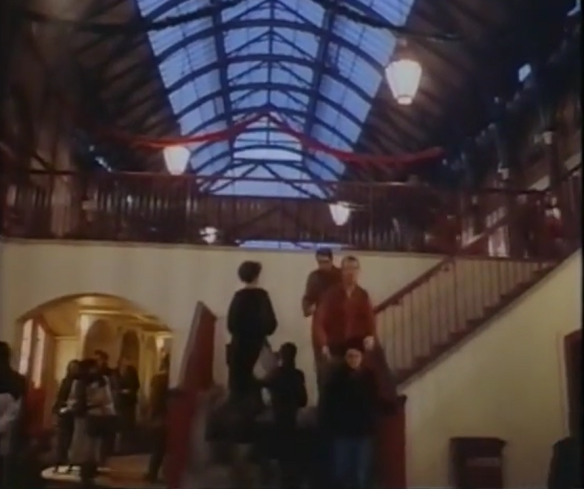 and then this translates down, in trickle down form, to a lining or outlining in tinsel being all that is required or even desired of Christmas decoration, such as at this fancy restaurant,
and then this translates down, in trickle down form, to a lining or outlining in tinsel being all that is required or even desired of Christmas decoration, such as at this fancy restaurant, the entryway reframed at a Christmas party
the entryway reframed at a Christmas party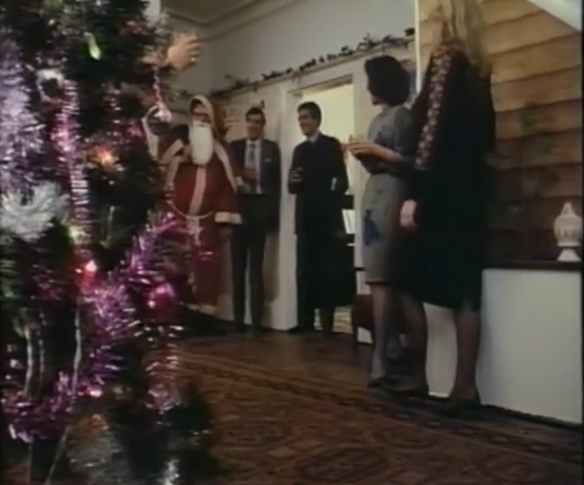 Where santa appears
Where santa appears around a mirror in a dressing room
around a mirror in a dressing room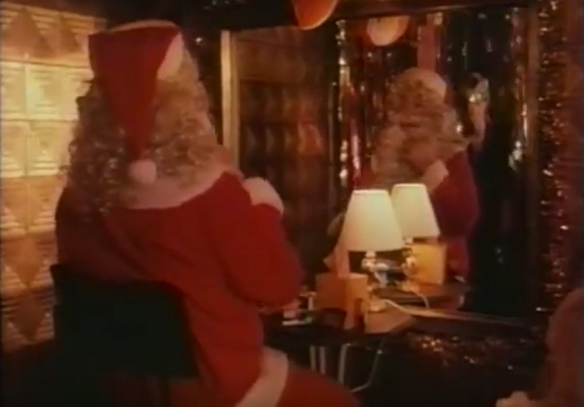 and even just at the side of a backdrop for an erotic photo shoot
and even just at the side of a backdrop for an erotic photo shoot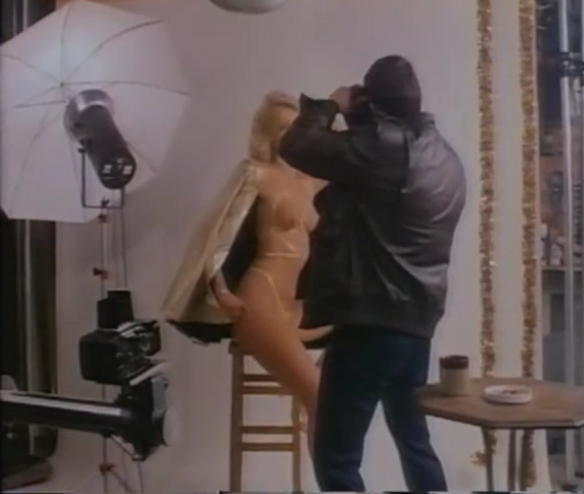 what this means is that the Brits, at the time, only needed to reframe the everyday in a frisson of tinsel, and that was enough. The added outlining given things by its glitter, and its movement, was sufficient to alter the state of mind. As a device, such simple outlining of the existing infrastructure would be an example of static imagination, just slightly altering the visuality of the everyday, to incite a slightly higher level of interest. That means that we are in a state, here, in the middle of a crime wave , but only as a static adding electricity to the scene, and not as an alternative reality (and people involved are being constantly reminded that others are in the state). Therefore, it may be that the strand of tinsel was considered a bit more than usual, and a bit more importantly interpreted, in Britain, than in my first appraisal, because it is part of this general enlivening, this stained-glass windowing of time and space during the holiday.
what this means is that the Brits, at the time, only needed to reframe the everyday in a frisson of tinsel, and that was enough. The added outlining given things by its glitter, and its movement, was sufficient to alter the state of mind. As a device, such simple outlining of the existing infrastructure would be an example of static imagination, just slightly altering the visuality of the everyday, to incite a slightly higher level of interest. That means that we are in a state, here, in the middle of a crime wave , but only as a static adding electricity to the scene, and not as an alternative reality (and people involved are being constantly reminded that others are in the state). Therefore, it may be that the strand of tinsel was considered a bit more than usual, and a bit more importantly interpreted, in Britain, than in my first appraisal, because it is part of this general enlivening, this stained-glass windowing of time and space during the holiday. This then is even more deeply connected with her in her confrontation, rather humorous, with a professional nude model, rebuffing a suggestion that she too get in the buff to shoot, and the bare boob of the model is compared, why otherwise would it be added to the scene, to the scarf tossed around her neck, and that scarf is then linked to the strands of tinself behind her. Meaning that in addition to what the strands meant up to this point, they also now represent her mental knots and her confused ins and outs trying to work it all out.
This then is even more deeply connected with her in her confrontation, rather humorous, with a professional nude model, rebuffing a suggestion that she too get in the buff to shoot, and the bare boob of the model is compared, why otherwise would it be added to the scene, to the scarf tossed around her neck, and that scarf is then linked to the strands of tinself behind her. Meaning that in addition to what the strands meant up to this point, they also now represent her mental knots and her confused ins and outs trying to work it all out. When she is away from being related directly to the property of strands of tinsel decoration, that scarf is something of her calling card. In this shot, as she had another odd encounter with the inspector, with an implication that something inappropriate is developing between them, she is outside at a flea market, but, still, here too, the landscape in back of her spells trouble down the road for her, marks her (the strand of the tinsel then also anotyping rhyming with the strand of tinsels).
When she is away from being related directly to the property of strands of tinsel decoration, that scarf is something of her calling card. In this shot, as she had another odd encounter with the inspector, with an implication that something inappropriate is developing between them, she is outside at a flea market, but, still, here too, the landscape in back of her spells trouble down the road for her, marks her (the strand of the tinsel then also anotyping rhyming with the strand of tinsels). We also first get a view of that amazing lamp display, with a blue strand of tinsel draped or rather looped a few times over it, when she is on another line, this time a telephone line, an obsolete property in film, but, in 1984, very much an indicator of a character finding wiggle room in the crawlspaces of telephone communication with others. Notice to how she holds her hand and her head, they visually rhyme with that blue sunshine tinsel strand
We also first get a view of that amazing lamp display, with a blue strand of tinsel draped or rather looped a few times over it, when she is on another line, this time a telephone line, an obsolete property in film, but, in 1984, very much an indicator of a character finding wiggle room in the crawlspaces of telephone communication with others. Notice to how she holds her hand and her head, they visually rhyme with that blue sunshine tinsel strand As she seeks contact with one inspector, and then comes more and more in contact with the deputy inspector who is beginning to suspect the other, and as she accidentally finds out from a loose lipped maid of the other inspector’s visit to an insane asylum, and him being taken off the case, she becomes more and more entangled in the complications of the drama. For this reason, her apartment becomes, in fact, the main exchange place of the plot, the center of action, and of climax, so it is fitting that her threshold is festooned with strands, oddly placed (also loosely hung, as if indicating loose ends, and red herrings going nowhere)
As she seeks contact with one inspector, and then comes more and more in contact with the deputy inspector who is beginning to suspect the other, and as she accidentally finds out from a loose lipped maid of the other inspector’s visit to an insane asylum, and him being taken off the case, she becomes more and more entangled in the complications of the drama. For this reason, her apartment becomes, in fact, the main exchange place of the plot, the center of action, and of climax, so it is fitting that her threshold is festooned with strands, oddly placed (also loosely hung, as if indicating loose ends, and red herrings going nowhere) the inspector is signified as one involved in the suspicions and complications in this shot
the inspector is signified as one involved in the suspicions and complications in this shot and then the nature of their complicated conversation, not really going anywhere, with all the loops (including a strand apparently draped over what looks like a purely industrial picture)
and then the nature of their complicated conversation, not really going anywhere, with all the loops (including a strand apparently draped over what looks like a purely industrial picture)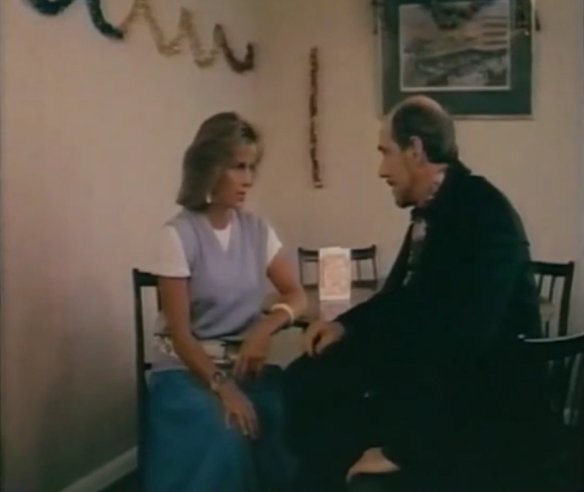 When the deputy gets up to leave, and puts on his hat, none the wiser for their talk, his confusion is accented by the strands, and extras, in the chandelier
When the deputy gets up to leave, and puts on his hat, none the wiser for their talk, his confusion is accented by the strands, and extras, in the chandelier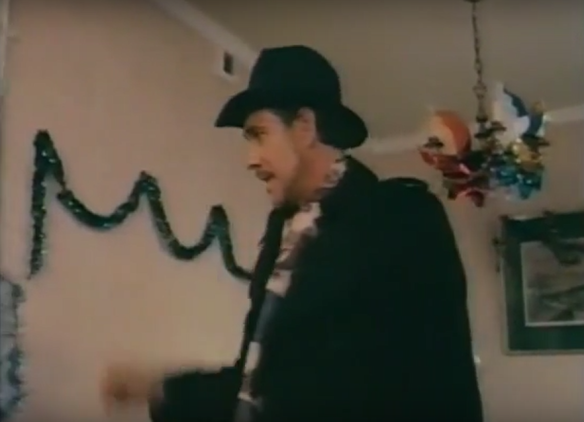 A very weird bit of Christmas decoration that I just cannot make out
A very weird bit of Christmas decoration that I just cannot make out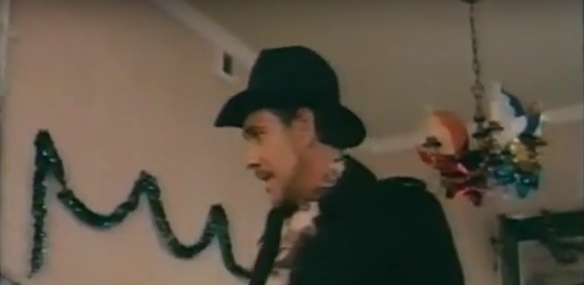 that lamp ending their engagement, expressive of all the loose ends and loops and confusions left between them
that lamp ending their engagement, expressive of all the loose ends and loops and confusions left between them So, for all this, these are by no means, incidental decorations, they are properties with an almost instrumentalized purpose to signal silently on screen that what you seeing and hearing is complication, but, somehow, suspicions and confusion swirling in particularly around her. It is almost as if at times this decoration is her totemic leitmotiv which signals her presence. But then things get more involved. She is at home again, this time, apparently, just after a shower, only in her robe. In this shot, she must be waiting for a call, because the blue loop on the lamp over the phone is pronounced, and in a state of being all to pieces, as indicated by that particularly depleted draping of a single strand on the back wall
So, for all this, these are by no means, incidental decorations, they are properties with an almost instrumentalized purpose to signal silently on screen that what you seeing and hearing is complication, but, somehow, suspicions and confusion swirling in particularly around her. It is almost as if at times this decoration is her totemic leitmotiv which signals her presence. But then things get more involved. She is at home again, this time, apparently, just after a shower, only in her robe. In this shot, she must be waiting for a call, because the blue loop on the lamp over the phone is pronounced, and in a state of being all to pieces, as indicated by that particularly depleted draping of a single strand on the back wall but now the murderer breaks into her apartment, and confronts her, and he is holding….a strand of decoration, their exchange is framed by it too
but now the murderer breaks into her apartment, and confronts her, and he is holding….a strand of decoration, their exchange is framed by it too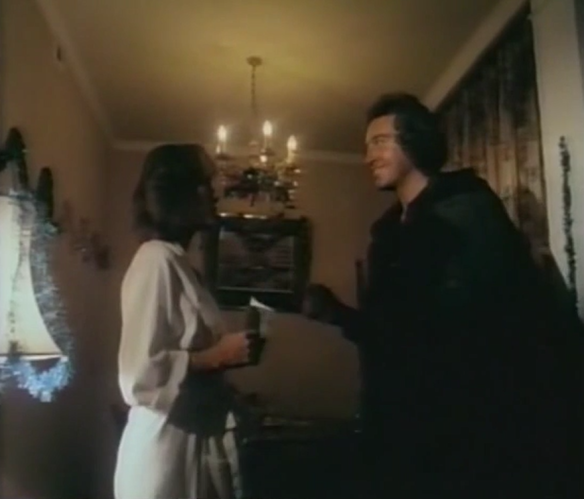 the loops of the strand on the wall now, on second thought, adding to the folds of her robe, indicating that she is naked under it, and therefore, vulnerable and exposed (no shower sequences in this one, this is as close as we get), they represent in their depletedness in this particular state and moment, her vulnerability
the loops of the strand on the wall now, on second thought, adding to the folds of her robe, indicating that she is naked under it, and therefore, vulnerable and exposed (no shower sequences in this one, this is as close as we get), they represent in their depletedness in this particular state and moment, her vulnerability and then as she grabs for the cord of the phone, he USES A STRAND OF TINSEL as the murder weapon, to strangle her
and then as she grabs for the cord of the phone, he USES A STRAND OF TINSEL as the murder weapon, to strangle her then, even more amazingly, clearly realizing that somehow her involvement in the case and her probing in to the connection between him and his brother, has lead to this moment, and that the blue strand on her lampshade is the totem and trophy of her her cognitions about the case, he removes that very blue strand, and tosses on her body, as a final insult of ‘this is where all your thinking on the case has gone”
then, even more amazingly, clearly realizing that somehow her involvement in the case and her probing in to the connection between him and his brother, has lead to this moment, and that the blue strand on her lampshade is the totem and trophy of her her cognitions about the case, he removes that very blue strand, and tosses on her body, as a final insult of ‘this is where all your thinking on the case has gone” then the deputy comes by and finds her and now her body is as depleted as the silver strand, not seen before, on the table below, and the total abjection of the blue strand, and his phone cord, is made apparent in her dead body lay out
then the deputy comes by and finds her and now her body is as depleted as the silver strand, not seen before, on the table below, and the total abjection of the blue strand, and his phone cord, is made apparent in her dead body lay out and why would this connect to the killer, and the idea arise to make of that strand a murder weapon. There is a suggestion in this shot, as tinsel is linked to a pyramid device made of metal, a candle version of a Christmas pyramid where if you light a candle the heat will cause the wheels to spin
and why would this connect to the killer, and the idea arise to make of that strand a murder weapon. There is a suggestion in this shot, as tinsel is linked to a pyramid device made of metal, a candle version of a Christmas pyramid where if you light a candle the heat will cause the wheels to spin this then links up to the burning Santa device at the beginning of the movie, a candle
this then links up to the burning Santa device at the beginning of the movie, a candle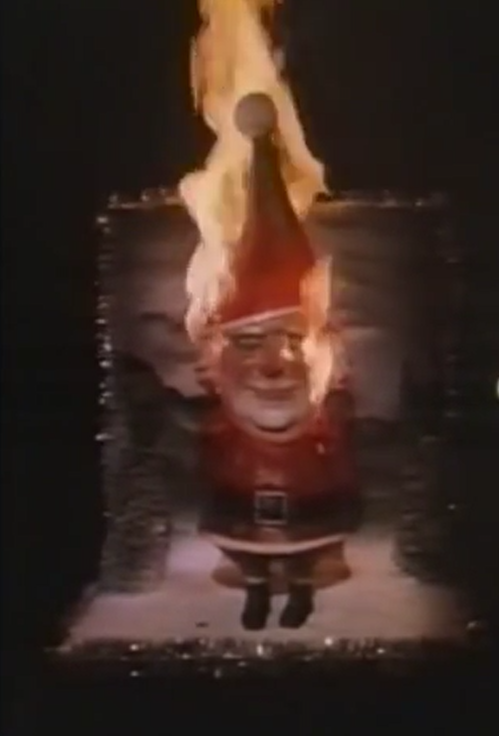
 and even now by fire
and even now by fire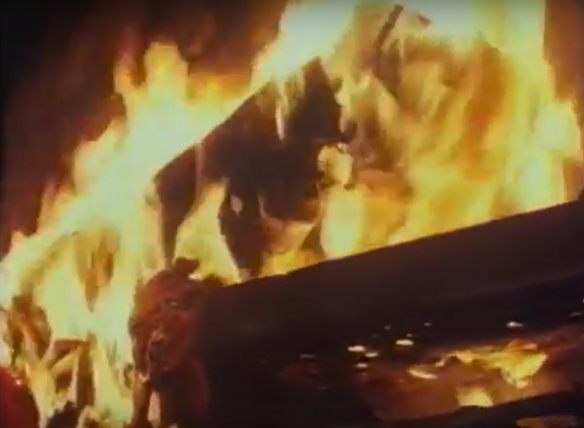 this then links up to the fact that as the movie progresses he has to break out of the purely symbolic freudian formula of razors used against santas, to actually do some killing of nonsantas, to protext his psychosis from being found out, and he starts with Briosky, then electrocutes the deputy, and then, after having entrapped the peep show girl, he takes a chain against her, and a chain of course is held pretty much in the same way as he held that tinself against Briosky
this then links up to the fact that as the movie progresses he has to break out of the purely symbolic freudian formula of razors used against santas, to actually do some killing of nonsantas, to protext his psychosis from being found out, and he starts with Briosky, then electrocutes the deputy, and then, after having entrapped the peep show girl, he takes a chain against her, and a chain of course is held pretty much in the same way as he held that tinself against Briosky indeed, the final sequence, in which he is vanquished by the pragmatism of the world, the girl who is practical, no problem if guys want to pay her five pounds for her to show them her tits, it is a veritable symphony of ominous, terrorizing chain play, and then in a classic psycho wormwhole formation of the spiral stair where here too all form is contracted into a run-on chain of railing, all of it indicating madness, and then when they have a battle up top it is by a yank on his chain that she sends up over, to fall to his death
indeed, the final sequence, in which he is vanquished by the pragmatism of the world, the girl who is practical, no problem if guys want to pay her five pounds for her to show them her tits, it is a veritable symphony of ominous, terrorizing chain play, and then in a classic psycho wormwhole formation of the spiral stair where here too all form is contracted into a run-on chain of railing, all of it indicating madness, and then when they have a battle up top it is by a yank on his chain that she sends up over, to fall to his death And then the punchlines, as we find out that he was out to kill santas because when he was a child at a Christmas party he caught his mother getting well and truly fucked by a guest dressed as santa, and the trim as it profiled her spread legs, and his not exactly knowing what was going on, then the santa lashing out, to knock his babysitter with her hairy armpts down the stairs, all of it stems then from the trim on santa’s outfit as it relates to visions of dicks menacing the trim of spread female legs, and goes from there
And then the punchlines, as we find out that he was out to kill santas because when he was a child at a Christmas party he caught his mother getting well and truly fucked by a guest dressed as santa, and the trim as it profiled her spread legs, and his not exactly knowing what was going on, then the santa lashing out, to knock his babysitter with her hairy armpts down the stairs, all of it stems then from the trim on santa’s outfit as it relates to visions of dicks menacing the trim of spread female legs, and goes from there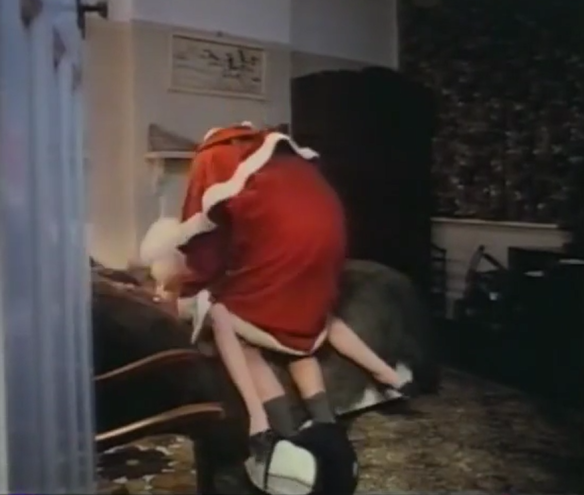 This formation here, in close up, being the deep structure source of the triggering power of a loop or strand of tinsel to rile him up
This formation here, in close up, being the deep structure source of the triggering power of a loop or strand of tinsel to rile him up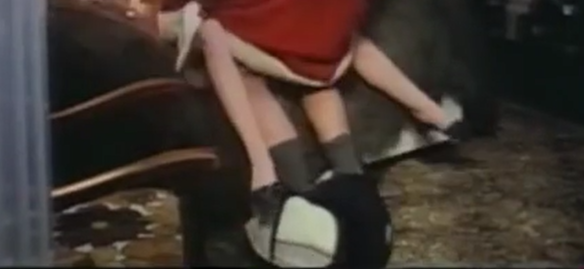 and that’s that. Though the movie has layered in over on top, on the explicit level of its doings, a whole series of vignettes with standalone, and apparently exploitatiional quality, and though it has pure exploitational vignette aspects that read on the surface as pure distraction from the plot and its doings, deep down in the structure of the flow of the movie, the tinsel strand, which at first looked purely incidental, not only comes to represent the suspicions and ins and outs of the investigation, the nature and part played by Briosky, symbolized by her apartment decorations, the complications of final complications she has with the deputy, and then with the murderer, and then even his murder weapon, and finally a signifier of his whole way of menacing, it’s quite surprising, the innocuous tinsel strand in Don’t Open til Christmas, the strands that keep the box closed, unravelling and being opened throughout the running of the movie, turn out to have been deeply instrumentalized as an important and consistent visual clue as to what was going on in the movie.
and that’s that. Though the movie has layered in over on top, on the explicit level of its doings, a whole series of vignettes with standalone, and apparently exploitatiional quality, and though it has pure exploitational vignette aspects that read on the surface as pure distraction from the plot and its doings, deep down in the structure of the flow of the movie, the tinsel strand, which at first looked purely incidental, not only comes to represent the suspicions and ins and outs of the investigation, the nature and part played by Briosky, symbolized by her apartment decorations, the complications of final complications she has with the deputy, and then with the murderer, and then even his murder weapon, and finally a signifier of his whole way of menacing, it’s quite surprising, the innocuous tinsel strand in Don’t Open til Christmas, the strands that keep the box closed, unravelling and being opened throughout the running of the movie, turn out to have been deeply instrumentalized as an important and consistent visual clue as to what was going on in the movie. she plays a reporter reporting on body protests
she plays a reporter reporting on body protests and then brings her stripped body into the picture as she imagines herself arrested at a protest, then hauled in by the cops, all in Trump wigs, and then strip searched, and maltreated in sexist abusive ways
and then brings her stripped body into the picture as she imagines herself arrested at a protest, then hauled in by the cops, all in Trump wigs, and then strip searched, and maltreated in sexist abusive ways then she is branded for her body image (though NT does not have that problem, to get trumpy about it)
then she is branded for her body image (though NT does not have that problem, to get trumpy about it)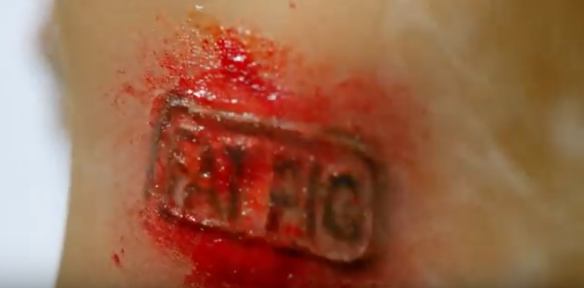 then after court, she is taken back to jail, presumably convicted, and branded again for being a PERVERT, which I assume means lesbianism, though I this sort of rhetoric was not part of the US campaign though likely derives from Russian origins in trying to police sexuality
then after court, she is taken back to jail, presumably convicted, and branded again for being a PERVERT, which I assume means lesbianism, though I this sort of rhetoric was not part of the US campaign though likely derives from Russian origins in trying to police sexuality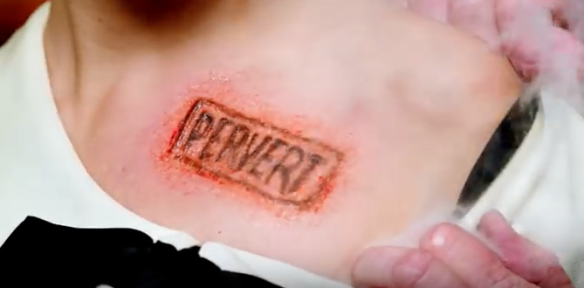 later in jail, the camera gives her body a full on top to bottom body lick, and NT gives us a bit of purposeful nipple slip wardrobe malfunction
later in jail, the camera gives her body a full on top to bottom body lick, and NT gives us a bit of purposeful nipple slip wardrobe malfunction then behind jail bars, and, in this, here again the outside-looking-in view of the foreign perspective equates America with the America projected in Old South speedtrap exploitation movies where girls are indeed brought into jails and raped, she is stripped, and presumably raped by the cop, only showing here, but it is enough, and, alas, very sexy, her underpants being pulled down, and down…very far before breaking away
then behind jail bars, and, in this, here again the outside-looking-in view of the foreign perspective equates America with the America projected in Old South speedtrap exploitation movies where girls are indeed brought into jails and raped, she is stripped, and presumably raped by the cop, only showing here, but it is enough, and, alas, very sexy, her underpants being pulled down, and down…very far before breaking away and then we see her in the suffering saint deposition pose in jail, with a toilet behind, reminding us that this very sexy body is in for some very opposite-of-sexy body maintenance issues inside (this clinical ew! corresponding to generational rupophobia regarding bodies superceding prior erotophobia, sex now seeming to many no biggee)
and then we see her in the suffering saint deposition pose in jail, with a toilet behind, reminding us that this very sexy body is in for some very opposite-of-sexy body maintenance issues inside (this clinical ew! corresponding to generational rupophobia regarding bodies superceding prior erotophobia, sex now seeming to many no biggee) this body theme doubles down again at the end when she is in another impersonation as a woman who needs an abortion, and she is carried in in a highly sexualized way (with a crotch shot here)
this body theme doubles down again at the end when she is in another impersonation as a woman who needs an abortion, and she is carried in in a highly sexualized way (with a crotch shot here)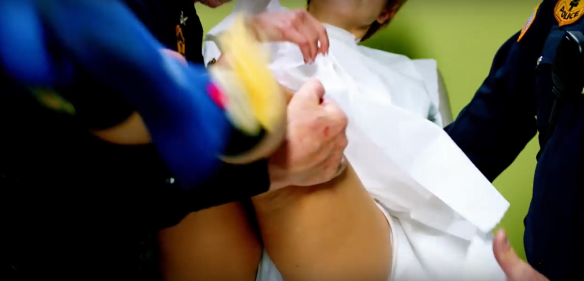 and then put up in the stirrups, but, then, rather than get her abortion, the doctor politicizes the event by branding her in her lower stomach area NO ABORTION, and then something happens by which she is beaten and killed, ending up laid out on the floor
and then put up in the stirrups, but, then, rather than get her abortion, the doctor politicizes the event by branding her in her lower stomach area NO ABORTION, and then something happens by which she is beaten and killed, ending up laid out on the floor and then zipped up into a body bag
and then zipped up into a body bag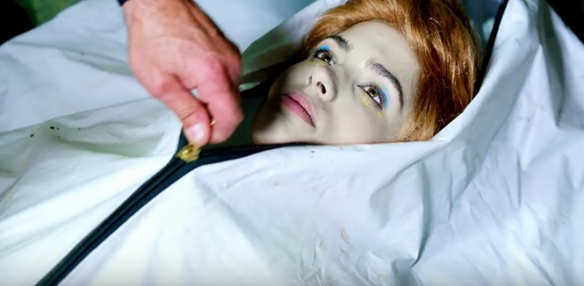
 and this pessimism, while for me, imaginging oneself in a body bag, talk to me Nadya
and this pessimism, while for me, imaginging oneself in a body bag, talk to me Nadya but this might turn off some more idealistic liberal voices in America, especially now in the ideal-reactionary period of let’s overturn the decision. At present, I am going to argue that though she toys with her own cult, she by and large gets free of it in a well-shot and worked out horror story scenario in which she plays the representative sacrificial victim, she taking on the pain, so that other women can vent, and perhaps feel, for the moment, safe.
but this might turn off some more idealistic liberal voices in America, especially now in the ideal-reactionary period of let’s overturn the decision. At present, I am going to argue that though she toys with her own cult, she by and large gets free of it in a well-shot and worked out horror story scenario in which she plays the representative sacrificial victim, she taking on the pain, so that other women can vent, and perhaps feel, for the moment, safe. and then on the back of her underpants is the familiar and rather famous pile of stinking shit meme of Trump that began to circulate amongst those believed Trump could be lampooned to defeat in May or June (I always thought this jocular approach was seriously flawed, grounded as it was in pre-March disbelief in his campaign as a big joke, whereas after he became the front runner in March, it was time to TAKE THIS VERY SERIOUSLY, and yet the jocular approach staggered on into the Fall, even NOW!, helplessly)
and then on the back of her underpants is the familiar and rather famous pile of stinking shit meme of Trump that began to circulate amongst those believed Trump could be lampooned to defeat in May or June (I always thought this jocular approach was seriously flawed, grounded as it was in pre-March disbelief in his campaign as a big joke, whereas after he became the front runner in March, it was time to TAKE THIS VERY SERIOUSLY, and yet the jocular approach staggered on into the Fall, even NOW!, helplessly) This suggests a strange transvestism. She is adorning herself with protest underpants. I suppose in the raw physical dynamics of this, she clothes herself in the enemy’s contentions in order to hold them close, to remind her of the danger, but then to turn them away, then also to make of her everyday actions in matter of body and sex a walking protest (the comparable device, though not comparable event, are people injured politically, who bear their mark forever after as a reminder, and the showing of concentration camp brand numbers on survivors arms is I guess the clearest example of a brand turned into a kind of forlorn badge of honor). This, however, is verbal-sartorial armor, and not a terrible idea (at present, though, I can’t think of that many examples of sartorial armoring in this way in real life: I mean, when people protest they say protest things in signage, but then on their bodies wear pro-their-position words, to wrap themselves up in their issue, and protect their body out that way. Rarely, my impression is at the moment, do you see a person adorn oneself in the armor of the others’ taunts).
This suggests a strange transvestism. She is adorning herself with protest underpants. I suppose in the raw physical dynamics of this, she clothes herself in the enemy’s contentions in order to hold them close, to remind her of the danger, but then to turn them away, then also to make of her everyday actions in matter of body and sex a walking protest (the comparable device, though not comparable event, are people injured politically, who bear their mark forever after as a reminder, and the showing of concentration camp brand numbers on survivors arms is I guess the clearest example of a brand turned into a kind of forlorn badge of honor). This, however, is verbal-sartorial armor, and not a terrible idea (at present, though, I can’t think of that many examples of sartorial armoring in this way in real life: I mean, when people protest they say protest things in signage, but then on their bodies wear pro-their-position words, to wrap themselves up in their issue, and protect their body out that way. Rarely, my impression is at the moment, do you see a person adorn oneself in the armor of the others’ taunts). then the head cop is proudly brandishing her Trump socks
then the head cop is proudly brandishing her Trump socks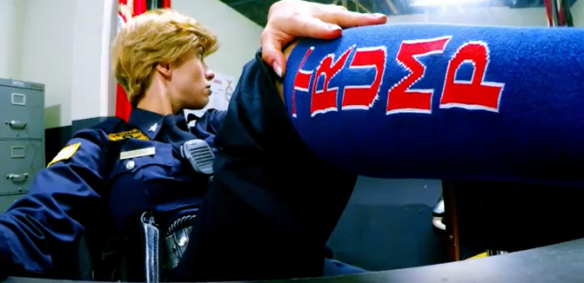 later a judge, again played by NT, is showing off her long leather boots, identifying her as a sadist
later a judge, again played by NT, is showing off her long leather boots, identifying her as a sadist and then NT as Trump also wears an American flag tie (they could’ve done better with this)
and then NT as Trump also wears an American flag tie (they could’ve done better with this) and also has quite create Trump red and blue make up, love the blue lips, and then NT’s Trump also wears Trump socks (here reversing the stirrup position to play the man with the all-encompassing manspread crotch who will grab all pussies into him
and also has quite create Trump red and blue make up, love the blue lips, and then NT’s Trump also wears Trump socks (here reversing the stirrup position to play the man with the all-encompassing manspread crotch who will grab all pussies into him

 But then the magic is done, and they are gone, and when gone, the feet, only in socks, curl up and wither in under the house, in this context then socks represented unshod of shoe and of the power emitted by shoes, a trope of helplessness
But then the magic is done, and they are gone, and when gone, the feet, only in socks, curl up and wither in under the house, in this context then socks represented unshod of shoe and of the power emitted by shoes, a trope of helplessness
 In the courts, there is a new seal, the Trump seal, and new flags, red, the Trump flag
In the courts, there is a new seal, the Trump seal, and new flags, red, the Trump flag Trump seal and Trump flag usurps the stars and stripes in the Oval too
Trump seal and Trump flag usurps the stars and stripes in the Oval too what I especially like about the Oval set up is that there is no attempt to set up the actual Oval the way the Oval looks, but the new Oval of the Trump regime is represented as this hole in the wall in a rented out office in some dingy office building, it exudes a sense of lack of legitimacy, and falseness, I love the bad paneling, the institutional drab-green wallpaper, the “we got to put something up” improv nature of the wall hangings, and then the black couches, which makes it all seem like a waiting area for a line of people coming for handouts, even the phony globe is funny, it is nicely cast (houseplant alert to in the corner, warning, trouble to come). This is a Russian idea, and it adds a strong zest to the video. At the same time, it is common movie trope, as ever since Hitler movies have been devising various regime signage systems, of flags and symbols, to convey the totalitarian nature of the new regime. And, in thinking of ways in which president NT-as-DT will rule, NT and director plumb the depths of this critique by going all the way back to Charlie Chaplin playing with a world beachball in The Dictator (strangely enough this week the world is shocked that DT called Taiwan, breaking diplomatic protocol going back to 1979, which means, yes, the world is just his playground, based on his understanding of it by way of his business dealings)
what I especially like about the Oval set up is that there is no attempt to set up the actual Oval the way the Oval looks, but the new Oval of the Trump regime is represented as this hole in the wall in a rented out office in some dingy office building, it exudes a sense of lack of legitimacy, and falseness, I love the bad paneling, the institutional drab-green wallpaper, the “we got to put something up” improv nature of the wall hangings, and then the black couches, which makes it all seem like a waiting area for a line of people coming for handouts, even the phony globe is funny, it is nicely cast (houseplant alert to in the corner, warning, trouble to come). This is a Russian idea, and it adds a strong zest to the video. At the same time, it is common movie trope, as ever since Hitler movies have been devising various regime signage systems, of flags and symbols, to convey the totalitarian nature of the new regime. And, in thinking of ways in which president NT-as-DT will rule, NT and director plumb the depths of this critique by going all the way back to Charlie Chaplin playing with a world beachball in The Dictator (strangely enough this week the world is shocked that DT called Taiwan, breaking diplomatic protocol going back to 1979, which means, yes, the world is just his playground, based on his understanding of it by way of his business dealings)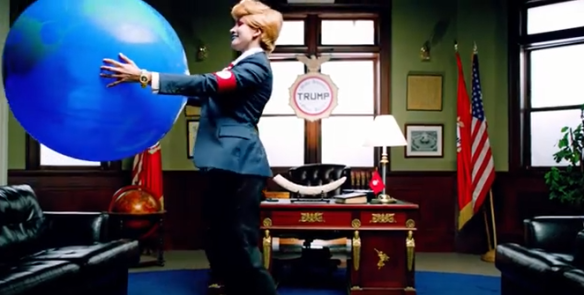 there is hardly even need to quote this source, but it is interesting that while Chaplin has a sort of comic ballet with the world ball, NT is playing with it more as a beachcomber looking out for sunning possibilities, slight change of tone
there is hardly even need to quote this source, but it is interesting that while Chaplin has a sort of comic ballet with the world ball, NT is playing with it more as a beachcomber looking out for sunning possibilities, slight change of tone And Chaplin also had a host of regime change signs (though the extent to which this is an effective critique, given what was actually happening in Europe, and what it took to get Hitler out, is another whole question, it is art, not politics)
And Chaplin also had a host of regime change signs (though the extent to which this is an effective critique, given what was actually happening in Europe, and what it took to get Hitler out, is another whole question, it is art, not politics)
 I guess I am going to say it is a black and white picture of an early atomic bomb test, bringing up the whole finger on the button critique of Trump (which never scored many points with the public, all that threat is too remote in time for most people), but as a picture on a wall of a man proud of his meetings with dignitaries and deeds it signifies that the new regime is proud of its bomb, and might just use it. As a picture, it speaks to older movies like Seven Days in May (1964)
I guess I am going to say it is a black and white picture of an early atomic bomb test, bringing up the whole finger on the button critique of Trump (which never scored many points with the public, all that threat is too remote in time for most people), but as a picture on a wall of a man proud of his meetings with dignitaries and deeds it signifies that the new regime is proud of its bomb, and might just use it. As a picture, it speaks to older movies like Seven Days in May (1964) as would the golf club, when it really did seem as if the presidency was the only thing between the world and atomic bomb destruction (the fact that DT has now appeared to nominate for the cabinet several actual military personnel suggests that once upon a time he watched this movie and maybe cheered for the other side
as would the golf club, when it really did seem as if the presidency was the only thing between the world and atomic bomb destruction (the fact that DT has now appeared to nominate for the cabinet several actual military personnel suggests that once upon a time he watched this movie and maybe cheered for the other side
 and then was recently moved to the other side of the room, where it hosted other figures, before Trump
and then was recently moved to the other side of the room, where it hosted other figures, before Trump so, no, it was not purposely, for that visit, moved to troll Trump (my joke though was that the mic boom gave voice directly to Washington in his portrait, so he says something, then falls off the wall, a terrible omen). But, it does indicate, and this is an area of some interest, the art that hangs in the Oval is often deemed to be political in nature: and NT decided that in the Trump regime, it will be proud pictures of atomic bomb blasts. But, then, getting back to Seven Days in May, DT’s rhetoric does at times sound a lot like that of Burt Lancaster as the treasonous general attempting a military coup (I saw the movie again in late September and it gave me chills, as I do, but not in a military way, think of this election as a coup of sorts, the fact that it has now gone military is more worrisome still), and since election he has appointed military personnel to key cabinet posts.
so, no, it was not purposely, for that visit, moved to troll Trump (my joke though was that the mic boom gave voice directly to Washington in his portrait, so he says something, then falls off the wall, a terrible omen). But, it does indicate, and this is an area of some interest, the art that hangs in the Oval is often deemed to be political in nature: and NT decided that in the Trump regime, it will be proud pictures of atomic bomb blasts. But, then, getting back to Seven Days in May, DT’s rhetoric does at times sound a lot like that of Burt Lancaster as the treasonous general attempting a military coup (I saw the movie again in late September and it gave me chills, as I do, but not in a military way, think of this election as a coup of sorts, the fact that it has now gone military is more worrisome still), and since election he has appointed military personnel to key cabinet posts. it is interesting that when this effigy of DT is brought out, she, in this cut shot, from another sequence of shooting, adorns a glitter version of her own effigy persona, as a masked memory of Pussy Riot (and the use of their masks were so novel when they first emerged, it became their trademark, odd). Now, this relates directly to my coverage of the campaign by way of FB by my favoring of Rachel Harrison’s “situation” at Naftali Greene Gallery in June
it is interesting that when this effigy of DT is brought out, she, in this cut shot, from another sequence of shooting, adorns a glitter version of her own effigy persona, as a masked memory of Pussy Riot (and the use of their masks were so novel when they first emerged, it became their trademark, odd). Now, this relates directly to my coverage of the campaign by way of FB by my favoring of Rachel Harrison’s “situation” at Naftali Greene Gallery in June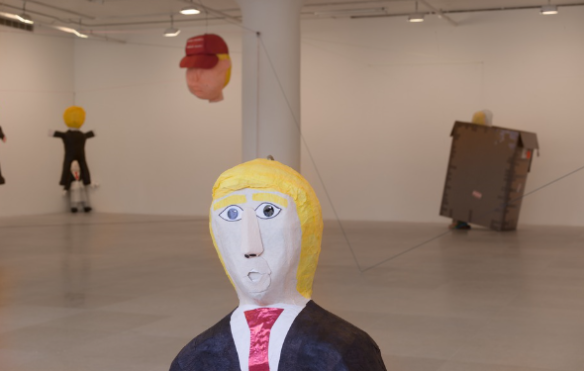
 Here is the link to the related piece, this relation, in fact, prompted this note
Here is the link to the related piece, this relation, in fact, prompted this note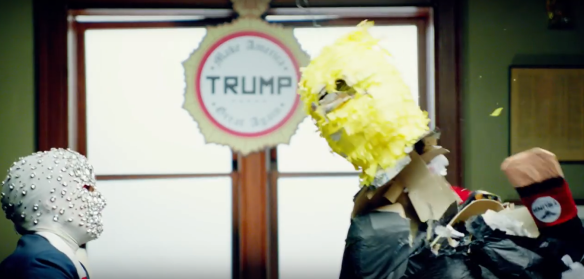 the whacking of the piñata also resulted in the whacking over of the two lamps the new prez had ersatzly plunked down on his temporary don’t-get-used-to-it desk and in movies as I have documented time and again a knocked over lamp means, time for chaos
the whacking of the piñata also resulted in the whacking over of the two lamps the new prez had ersatzly plunked down on his temporary don’t-get-used-to-it desk and in movies as I have documented time and again a knocked over lamp means, time for chaos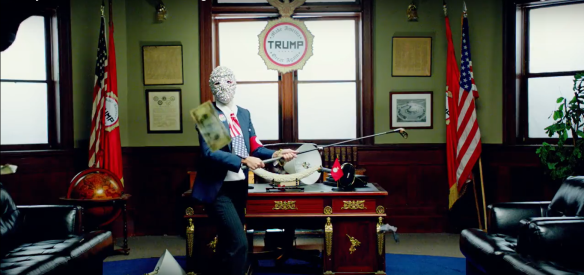 even better, but not exactly a new idea, is that the piñata turns out to be filled with money. Alas, they missed a money shot here, ala the Sopranos Andrew Jackson bullseye on Christopher’s mother’s frig (episode, For All Debts Public and Private)
even better, but not exactly a new idea, is that the piñata turns out to be filled with money. Alas, they missed a money shot here, ala the Sopranos Andrew Jackson bullseye on Christopher’s mother’s frig (episode, For All Debts Public and Private)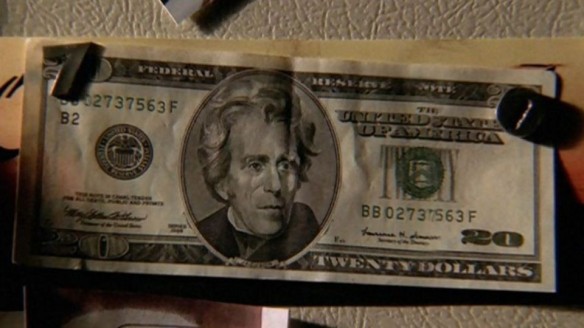 of the bill coming Jackson first, contrasted to the destroyed Trump, and the Pussy Rioter rioting against men
of the bill coming Jackson first, contrasted to the destroyed Trump, and the Pussy Rioter rioting against men but now the best part, the carpet of the Oval comes into play, after whacking the piñata, she gets down and wrestles with it
but now the best part, the carpet of the Oval comes into play, after whacking the piñata, she gets down and wrestles with it And then at least picking up on a warning I was trying to get ppl to pay attention to, he is a businessman, all he knows how to do is cut deals, in business, it is about money, but in a government context, not knowing procedure, so end-arounding with a business strategy, also mentioning money, the whole thing is going to turn into a corrupt mess, a patron passing out thanksgiving turkeys (or pinatas filled with money to his subservient voters). The money dance is an old movie device too, though no scene at the moment comes to mind (usually a mobster tossing stolen money all over his woman sprawled out on a motel bed)
And then at least picking up on a warning I was trying to get ppl to pay attention to, he is a businessman, all he knows how to do is cut deals, in business, it is about money, but in a government context, not knowing procedure, so end-arounding with a business strategy, also mentioning money, the whole thing is going to turn into a corrupt mess, a patron passing out thanksgiving turkeys (or pinatas filled with money to his subservient voters). The money dance is an old movie device too, though no scene at the moment comes to mind (usually a mobster tossing stolen money all over his woman sprawled out on a motel bed) and then, act three, it being a bit confusing in these cutaway mixing ins of different takes, she is dressed as DT, but wears the Pussy Riot mask (your own worst nightmare), but then in this sequence on the Oval carpet she strikes the sexy beast pose, imitating polar bear rugs on floors, but sexily crawling toward you
and then, act three, it being a bit confusing in these cutaway mixing ins of different takes, she is dressed as DT, but wears the Pussy Riot mask (your own worst nightmare), but then in this sequence on the Oval carpet she strikes the sexy beast pose, imitating polar bear rugs on floors, but sexily crawling toward you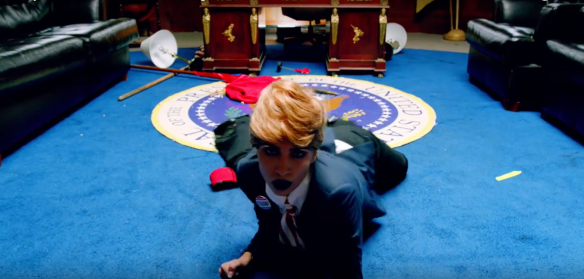 just like her many predecessors, like Bridget Bardot (in Contempt)
just like her many predecessors, like Bridget Bardot (in Contempt) Women in the modern period (pre 1980) were often associated with bear rugs in movies, here is an example from Valerie’s Week of Wonders (1968)
Women in the modern period (pre 1980) were often associated with bear rugs in movies, here is an example from Valerie’s Week of Wonders (1968)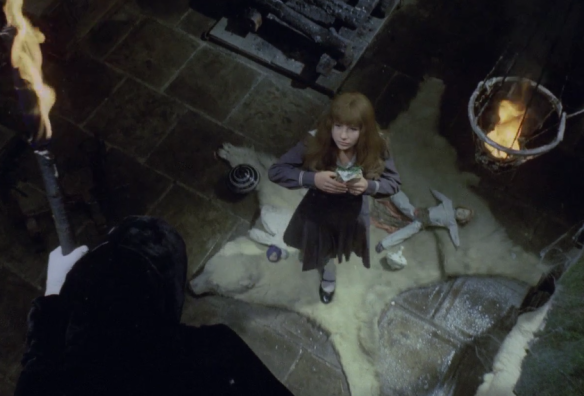 it equates them to natural creatures, irrational, etc etc., and the rug to a trophy too (possible trope going back to lore of Cleopatra’s delivery to Caesar) so this pose is doubly amusing for animalizing the seal eagle of the sacred Oval rug as just another bear rug to some folks and the weird thing is this too is another sly warning and critique of the star system and cult worship that has crept into our treatment of the presidency. At one point just after the election Aaron Sorkin the creator of West Wing, which began the tv fetishizing and cultification of the Oval, wrote a letter to his son trying to explain why the cultural dimension and trend that he touched off has lead to us electing a reality star (no, really, he wrote the letter in shock, but…he’s the man who started all this!). Now we have Scandal, Madam Secretary, VEEP, House of Cards, it’s like the Oval is the ultimate star place, and here is NT having her turn as sexy prez to wow us all, it is funny and, as everything in this video, smart. And it seems, from this, that Nadya too gazes confusedly on Americanisher TV and wonders, as I do, every Thursday night when Scandal is on, “what the FA-UCK is the matter with people who need to see the Prez getting it on in the Oval? I mean what KIND of person gets turned on by a White House humping?” Maybe we are buying all this “loneliest job in the world” crap, and sighing, aw, let’s get him some Oval booty (one dreads even suggesting that “the oval” and the other V word of this era, vagina, have strangely fused in the darkest corners of the tabloid imagination, forcing us to unconsciously elect Symbolic Alpha Males to “fuck that shit” every four years—I know the rationalists like to call it “sexism” but it goes deep); maybe, the President has in the 21st century become our tacit king (or, in Obama’s case, Saint), and we need some romance in the royal family story. It is a mystery, and possibly rooted in the Clinton scandal of “not have sex with that woman” that happened in the Oval a long time ago (news culture of course pathologically denies the influence of entertainment culture on politics today, but, hello, fellow Shondalanders, country just elected a reality star as president, paying attention please). Anyway, NT in one crawl slyly parodying all this is fun too
it equates them to natural creatures, irrational, etc etc., and the rug to a trophy too (possible trope going back to lore of Cleopatra’s delivery to Caesar) so this pose is doubly amusing for animalizing the seal eagle of the sacred Oval rug as just another bear rug to some folks and the weird thing is this too is another sly warning and critique of the star system and cult worship that has crept into our treatment of the presidency. At one point just after the election Aaron Sorkin the creator of West Wing, which began the tv fetishizing and cultification of the Oval, wrote a letter to his son trying to explain why the cultural dimension and trend that he touched off has lead to us electing a reality star (no, really, he wrote the letter in shock, but…he’s the man who started all this!). Now we have Scandal, Madam Secretary, VEEP, House of Cards, it’s like the Oval is the ultimate star place, and here is NT having her turn as sexy prez to wow us all, it is funny and, as everything in this video, smart. And it seems, from this, that Nadya too gazes confusedly on Americanisher TV and wonders, as I do, every Thursday night when Scandal is on, “what the FA-UCK is the matter with people who need to see the Prez getting it on in the Oval? I mean what KIND of person gets turned on by a White House humping?” Maybe we are buying all this “loneliest job in the world” crap, and sighing, aw, let’s get him some Oval booty (one dreads even suggesting that “the oval” and the other V word of this era, vagina, have strangely fused in the darkest corners of the tabloid imagination, forcing us to unconsciously elect Symbolic Alpha Males to “fuck that shit” every four years—I know the rationalists like to call it “sexism” but it goes deep); maybe, the President has in the 21st century become our tacit king (or, in Obama’s case, Saint), and we need some romance in the royal family story. It is a mystery, and possibly rooted in the Clinton scandal of “not have sex with that woman” that happened in the Oval a long time ago (news culture of course pathologically denies the influence of entertainment culture on politics today, but, hello, fellow Shondalanders, country just elected a reality star as president, paying attention please). Anyway, NT in one crawl slyly parodying all this is fun too